21 Best Towns in Tuscany + 7 Unique Day Trips (2023 Guide)
Looking for the best towns in Tuscany?
Oh Tuscany, the land of picturesque green rolling hills, paths lined with olive trees, vineyards as far as the eye can see, and charming Tuscan villages. We have enjoyed spending time exploring the best towns in Tuscany with our kids on two separate occasions. This time, we ventured for 3 months around Tuscany, Italy while our kids attend a world school in Pistoia (a lesser-known city in Tuscany).
Per usual, we love to journey out by car or train, exploring not only the well-known Tuscany sites but also the small towns in Tuscany—the ones that don’t always make the main lists of Best Towns in Tuscany!
Here, you’ll find some new ideas for day trips in Tuscany and just outside of Tuscany.
Our content is reader supported, meaning that at no additional cost to you, we may receive a commission if you click through and make a purchase from some of our links. For more information, read our disclosure here.
Traveling Throughout Tuscany Tips
Note that some towns in Tuscany are quite easily reached by train, while others really do require renting a car or hiring transportation. Hiring drivers in Tuscany is not cheap and if you are planning to rent a car during high season, make sure to reserve one ahead of time.
💡TIP: If you don’t know how to drive a Manual, make sure you check that your rental car location has Automatic cars!
BEFORE YOU GO: Download the App: TrainLine
This lets you book your train travel from your phone! While most of the time you can just walk up and purchase a ticket, there are times when the line is long. Also, note that during the high season or holidays, you’ll want to book your important train tickets in advance.
Ready to Plan? Check out these Travel Resources!
Safety Wing has been our go-to for trip insurance over the last few years. They are affordable and it’s easy to receive a quick quote.
Booking.com is the platform we use most often for booking accommodations!
Best Towns in Tuscany to Visit
Not only will you find a list of the best towns in Tuscany, but you’ll also find other great day trips and experiences for your vacation.
If you plan to stay overnight in any of these towns, I usually start with booking.com to seek out the best accommodations in Italy.
I recommend basing yourself somewhere and taking day trips from there. Anything around Florence is quite central. Although Florence is increasingly more and more crowded so if it were me, I’d choose a less crowded town.
We loved being based in Pistoia. This small city is less crowded and has easy train access. We also rented a car from the Hertz location in town. Just note that the car rental locations in the smaller towns aren’t typically open on the weekends.
THINGS TO KNOW BEFORE DRIVING IN ITALY
👉 There are lots of toll roads in Italy. You can pay for tolls by credit card.
👉 There are camera speeding traps all over. Signs are placed so you’ll know they are present. Another indication is when traffic slows down.
👉 Most cars are manual. So if you need an automatic car, reserve it ahead of time to make sure there is one available.
👉 Most of the beautiful towns in Tuscany have a historic center in which rental cars are NOT allowed to drive.
👉 Parking can be tricky. Usually on the outskirts of town, there are free parking spots or paid parking lots.
Now onto the list of the best towns in Tuscany to help you plan your incredible trip to Italy!
1. Montecatini AND Montecatini Alto
Located between Florence and the beaches is the charming town of Montecatini Terme with enticing thermal pools and a pretty promenade.
Plus, you get a bonus by being able to explore the cool medieval town, located on Montecatini Alto on the hilltop of Montecatini.
Montecatini Alto is the supersmall but scenic village on top of the mountain. There is a main piazza with restaurants to choose from and gelato for good measure. We ate a nice lunch and enjoyed the sunny piazza before wandering around to explore more.
💡NOTE: Most of the lunch places don’t start serving food before 12:00, however, there are a couple of spots that serve an early lunch!
There is a church at one end of town and a clock tower at the other. Both sides of the skinny village hold gorgeous panoramic vistas of the Tuscan hills and valleys below.
We really enjoyed our short trip there and would recommend it for a half-day excursion. Montecatini Terme is also nice to walk through the pedestrian zone of shops and cafes!
How to Get to Montecatini
Train: Easy train trip!
There are 2 train stops for Montecatini, you can take either.
We chose the 2nd (“Montecatini Centro”) but were penalized with a 10-minute wait while another train had to pass by. We have since realized that this happens regularly, so if you are coming from Florence, it may be worth getting off at the first stop “Montecatini Terme”.
If you are coming from Viareggio, get off at Montecatini Centro.
Things to Do in Montecatini & Montecatini Alto
✔️ Ride the Funicular Train
Our mission was to ride the funicular, so we charted a walk straight through the main promenade to get to the funicular train station (~15-20 minute stroll).
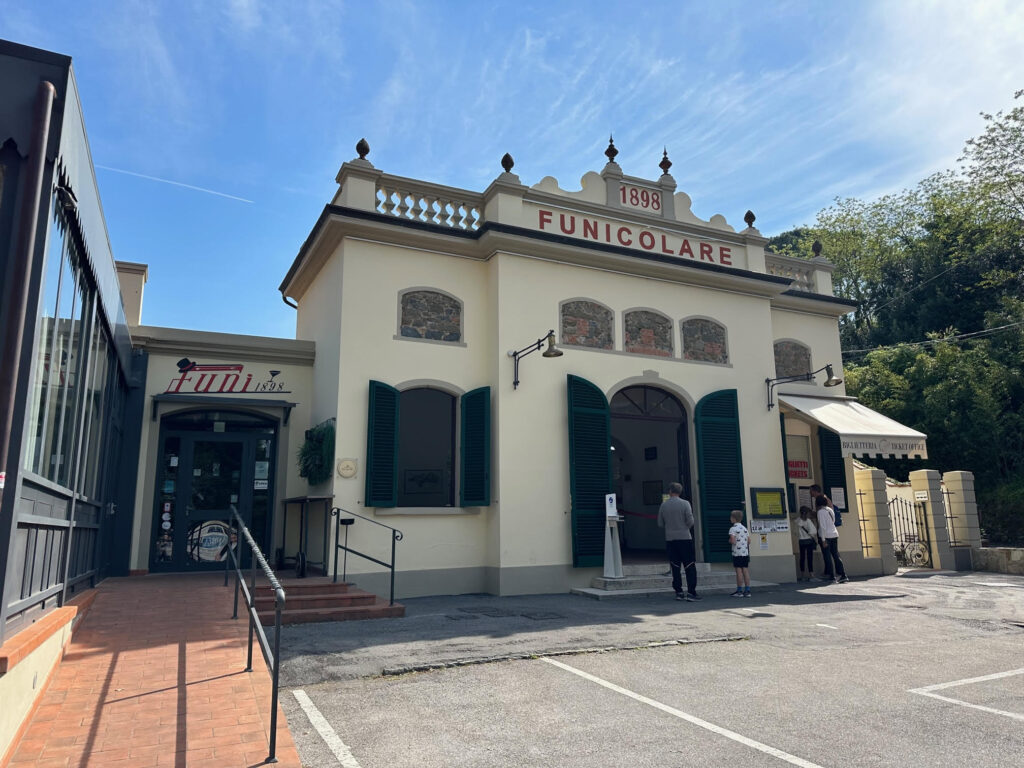
Even though the scheduled times for this inclined train are every 30 minutes, the funicular leaves whenever it feels full or when they feel like it.
The cost to ride Montecatini Alto Funicular is €7.50 roundtrip per adult and €4 for kids 6-10yo.
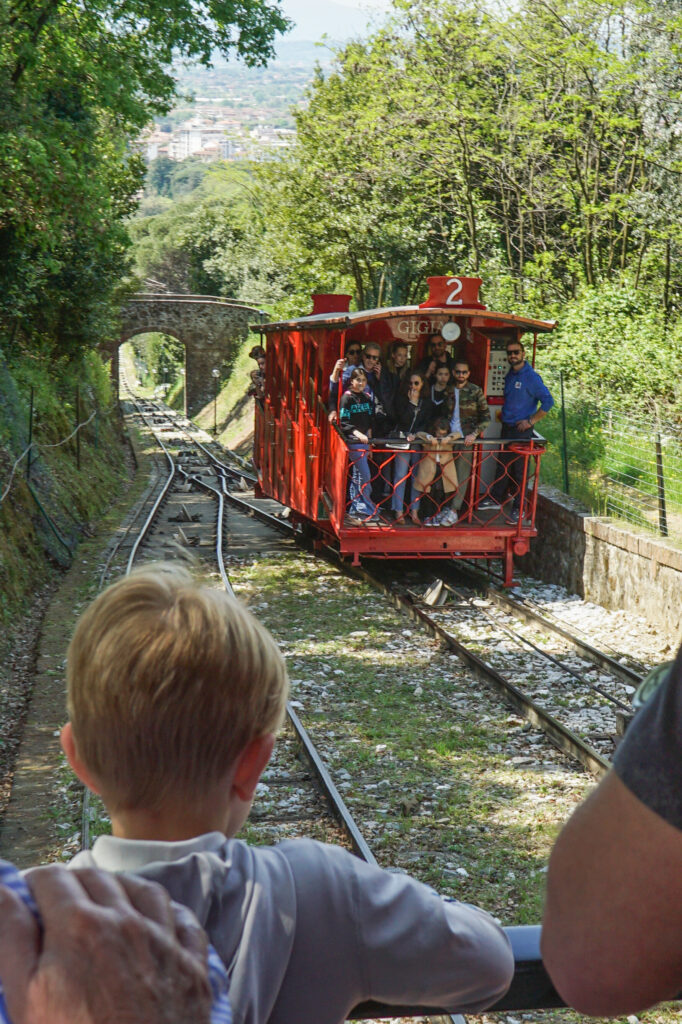
THINGS TO NOTE
👉 There is a free 1 stall bathroom at the station.
👉 The funicular train in Montecatini takes a break from 1:00-2:30 (13:00 – 14:30). Yes, the funicular has a siesta too so plan accordingly!
👉 Grab a front or back (outdoor!) standing spot on the Funicular Train for the best views. The ride up is smooth and the view opens up as you approach the top station.
✔️ Take a Hike
You can also opt to walk down from Montecatini Alto to Montecatini if you want to skip the Funicular ride both ways.
And if you’re heading back down to Montecatini, you can meander through the pedestrian zone of shops and cafes.
✔️ Relax at a Thermal Spa
You can also choose to spend the afternoon at the Thermal Spa. Terme Tettuccio is one of the main thermal spas with absolutely gorgeous architecture and grounds.
Where to Stay in Montecatini
We didn’t stay in Montecatini, as we were based in nearby Pistoia. However, there were some beautiful hotels (mansion style) and B&B that you can check out if you want to base yourself in Montecatini.
I recommend booking your accommodation in advance on Booking.com.
2. Siena
As one of the Tuscan towns with the most tour groups parading through, it is crucial to plan wisely for your visit to Siena.
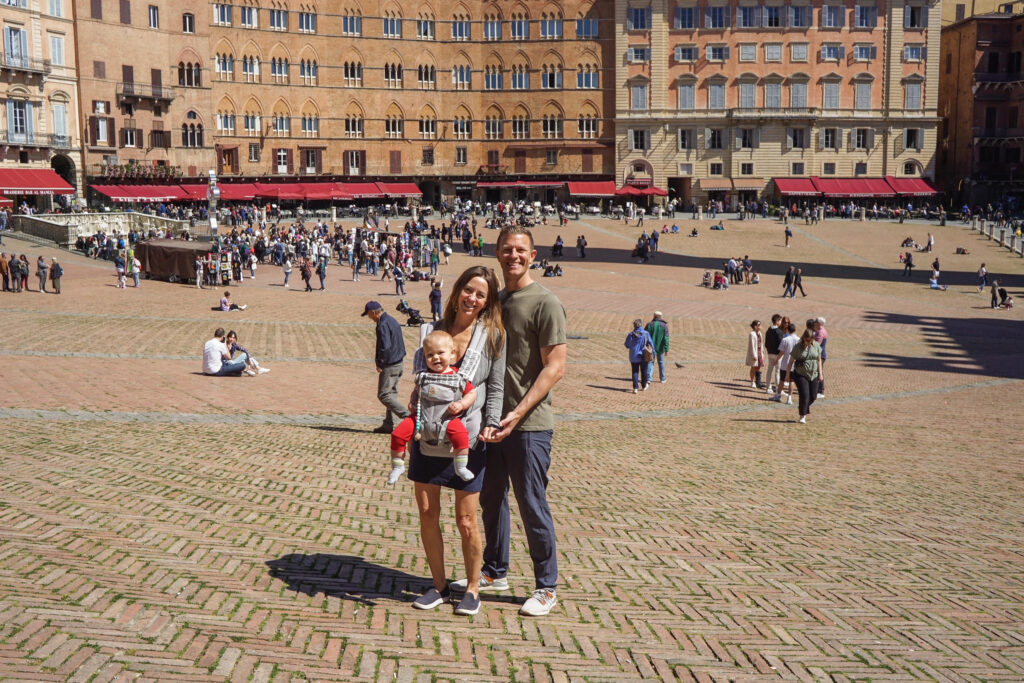
How to Get to Siena
Recommended Car Trip. A popular tourist town!
The location makes it not a direct nor short train trip from where we were staying in Pistoia, so we rented a car on a weekday to make a day trip out of it.
Note that most of the roads to Siena are toll roads and paying by credit card is easiest!
Parking in Siena
We pulled in straight to a parking garage (Parcheggio Santa Caterina at €2/hour). It’s strategically located near the public escalators that cleverly and kindly coast you up to the hilltop town. This is especially nice for those with mobility issues.
Things to Do in Siena
There are 3 main attractions for us:
✔️ The heavily adorned Santa Maria della Scala cathedral.
✔️ The sprawling Piazza del Campo where the Palio di Siena horse race takes place in July and August.
✔️ The gently winding street of shops for eats and treats of Via di Citta.
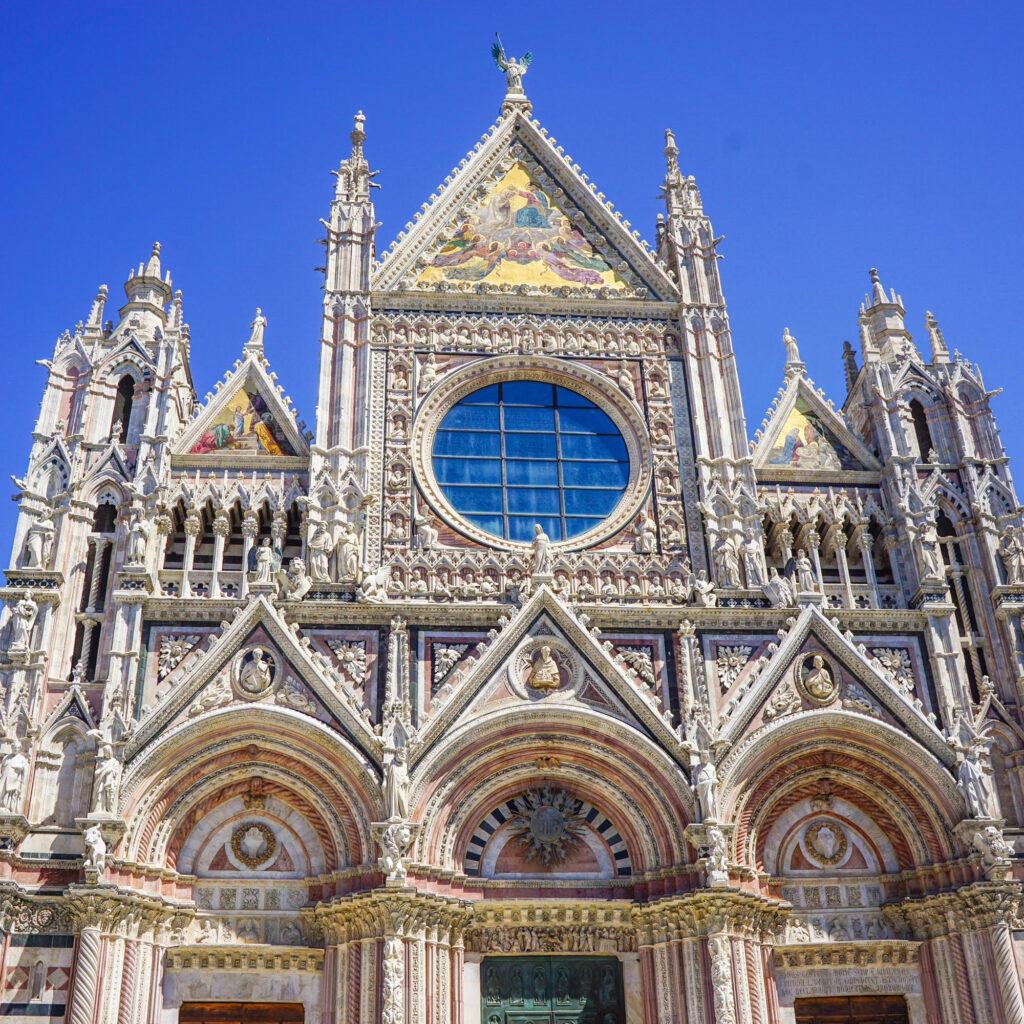
Tips for Visiting Siena
👉 Arrive as early as possible to beat the tour buses.
👉 There are many tourist-catering restaurants on the piazza to sit for a meal and imagine the jockeys careening the horses around each corner of the piazza.
👉 When leaving the parking garage there is a pay station up top to slide in your ticket to pay, you then have 15m to exit.
💡FUN FACT: The symbol of Siena is the she-wolf nursing Romulus and Remus
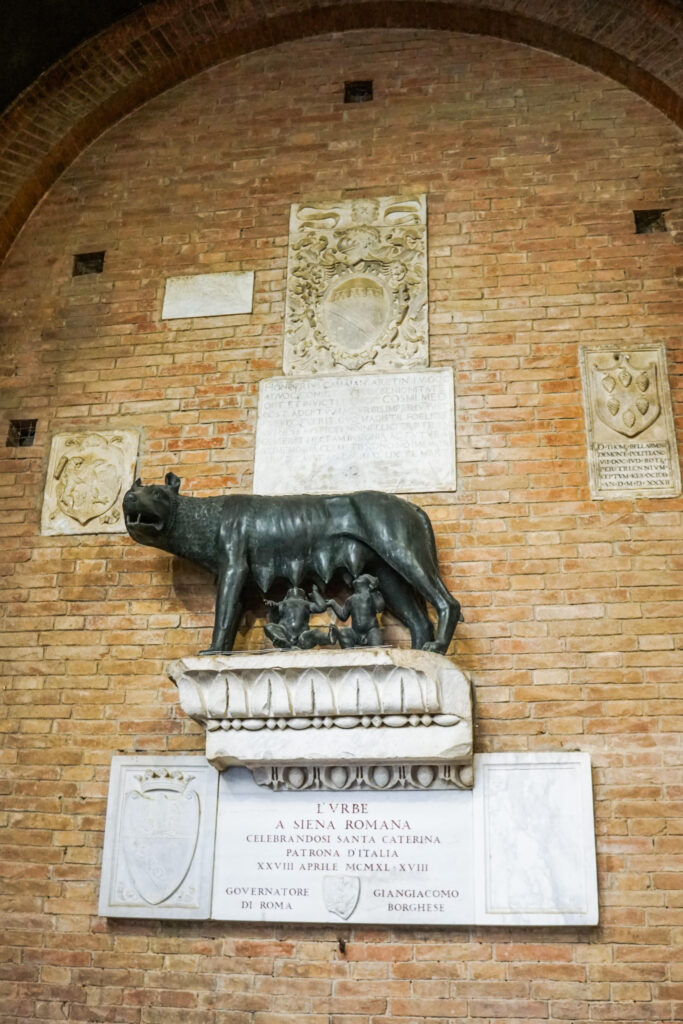
Where to Stay in Siena
I would recommend checking out Booking.com for the best hotels to meet your budget!
3. San Marino – A country within Italy!
Okay, okay, it’s not exactly a town in Tuscany, but it is A COUNTRY within Italy that isn’t the Vatican!
You can check another country off your list with a visit to this tiny nation completely surrounded and landlocked by Italy.
Located towards the east coast town of Rimini, this city-state has been independent since the early 300s. It’s not accessible by train, so a rental car is your best bet to get you to this medieval hilltop city center.
This fifth-smallest country in the world, San Marino has the oldest constitutional republic in the world dating back to 1600. If you stay long enough you may be eligible to be head of state. Every six months 2 captains regents from opposite parties are elected to share this post.
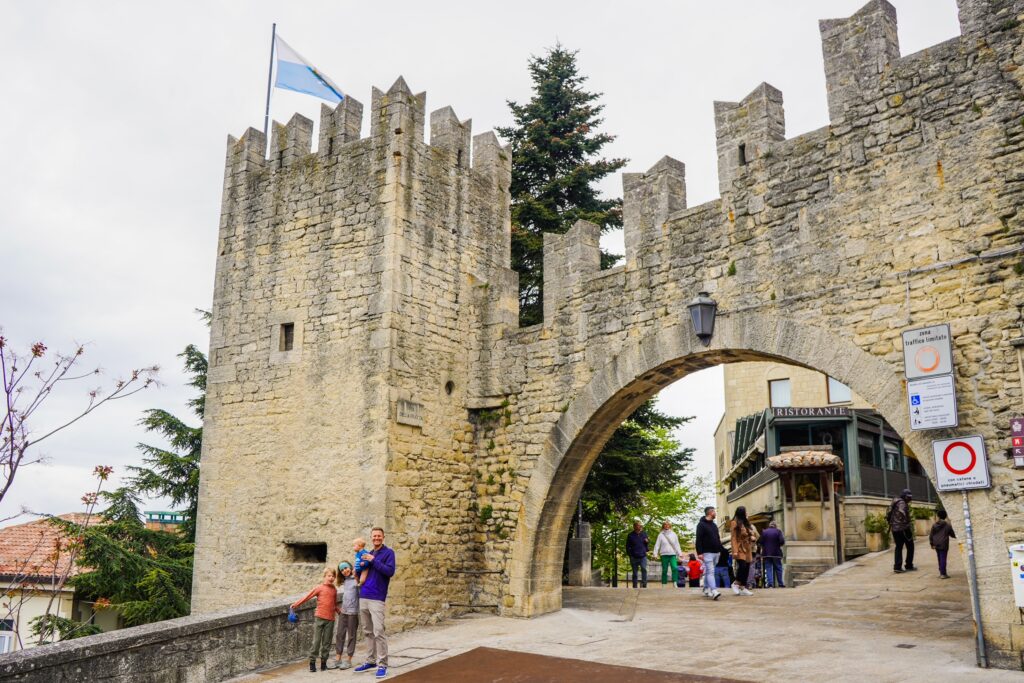
How to Get to San Marino
By car is definitely the easiest, as it is about a 3-hour car ride from Florence.
Parking in San Marino
We had plans to park in a lot near the top gate, but on a Saturday there were police directing/forcing tourists to park in a lower lot. It’s actually quite nice that they had police directing instead of a bunch of tourists not knowing where to go!
Things to Do in San Marino
Here are some fun things to do while visiting San Marino.
✔️ Ride a Tourist Train/Bus: Fun for Kids!
This worked out just fine as there was a cute tourist train/bus outside the garage that rode us up to the top for 3 euro per adult and big kids.
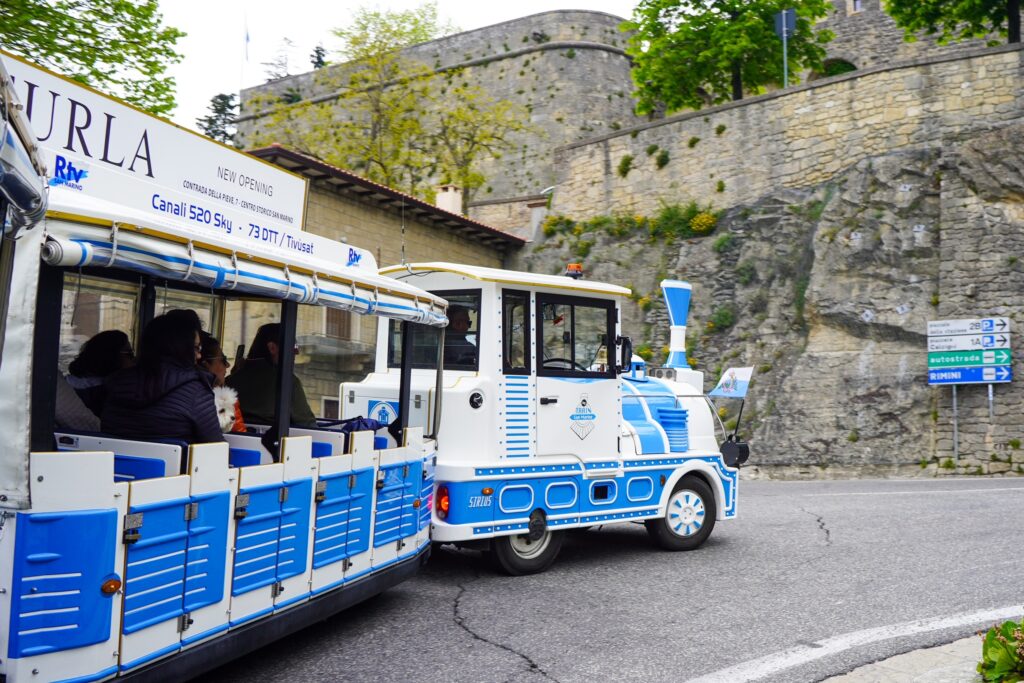
💡 NOTE: There is also a cable car from a lower spot we hadn’t known about which looked to be a splendid way to transport you up.
But there were no parking spots for it by the time we got there. I’d vote to try this route if you have the option to.
✔️ Stroll Through the City and Castles
The castle walls and city center are quite charming with a pedestrian promenade of shops and restaurants to wander up and down the stone streets. The castle towers have an entry fee, but a package deal allows entry into all of them.
We scored a rainy day, so we opted to not pay for the outdoor castle grounds entry fee and instead explored the shops. We then had lunch until the raindrops were held so we could admire the panoramic vistas and hike the castle walls that are publicly accessible, which occupied us for the afternoon.
We had other plans, but imagine it would be an amazing sunset and/or sunrise if you have the chance to stay in the evening or overnight. The city is perched on a super high hill which is really impressive to see coming or going.
💡 FUN FACT: Apparently, because of its strategic hard-to-reach hilltop location, Napoleon declared he would not conquer San Marino, one of the many reasons the country still exists today.
✔️ Walk Down the Hill
We chose to walk back to the parking garage instead of paying for the tourist train back. We meandered down a twisting series of streets lined with shops, a very relaxing and peaceful stroll down the hill.
✔️ Explore Unique Museums
If you love museums, especially weird unique museums, San Marino is known for its variety of interesting museums that you can check out all over the town/country!
Overall it is definitely lengthy for a day trip, but exciting to visit another country! Plus, it was really fun walking along the high castle walls and skipping in and out of the shops.
Where to Stay in San Marino
Check out Booking.com for the best hotels to meet your budget. We suggest staying in the old town to be able to walk to all the cute shops and cafes.
4. Pennabilli
Since we mentioned San Marino as a fun Day Trip from Tuscany, we need to mention this small village of Pennabilli, which makes a perfect stop on the way to or from San Marino from Tuscany.
This is definitely off the tourist route and you’ll need a car to get to Pennabilli. But it’s worth it and here is why.
We chose the slow scenic route back from San Marino and this little quaint town of Pennabilli was less than an hour away.
The only reason we knew to find this gentle gem was because of a podcast episode that proves you can find love late in life; you can show up for your partner no matter the distance; you can find purpose after loss; and you can find the sounds of silence if you roam around Italy long enough.
If you are a fan of Phoebe Judge (narrator) or just a fan of love, give this a listen here.
How to Get to Pennabilli
Get there by car. It’s just under 1 hour from San Marino and 2.5 to 3 hours from Florence.
Parking in Pennabilli is easy and free just off the historic center.
Things to Do in Pennabilli
✔️ Explore the Main Piazza
This small Italian village proved true to be a quiet one with no fanfare and easy access to explore away. The principal piazza has a friendly fountain, a cherished church, a poppin’ pizza place, and gooey gelato—basically the core ingredients of an Italian village and everything you actually need in life.
As we wandered betwixt the alleys up and down we kept uncovering hidden wonders just beneath the surface.
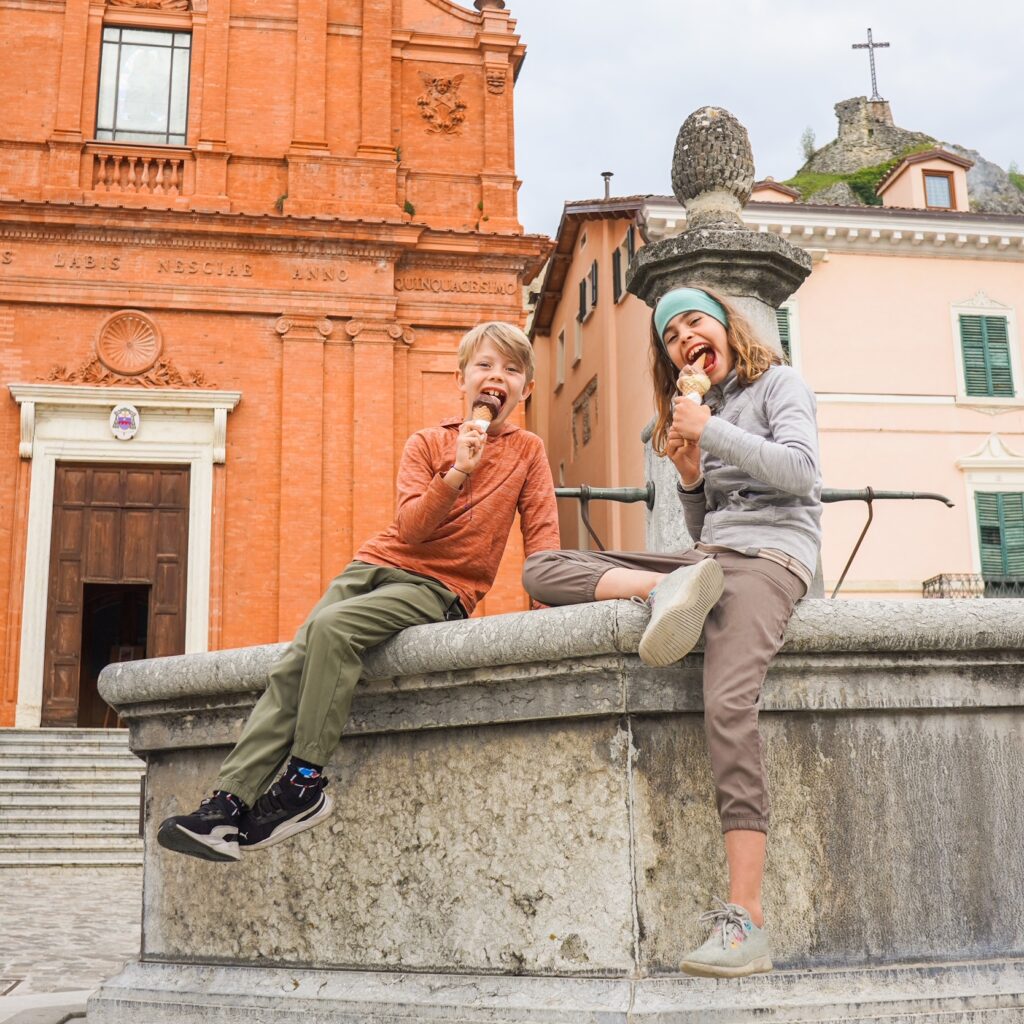
✔️ Connect with Nature
First, we stopped at a lookout to hold our breath to hear every single sound of the nature surrounding us. This land is calm and serene and natural and proud and unapologetic and unbothered by the faster pace of the world around it.
✔️ Bell of Lhasa
Next, we stumbled upon the Bell of Lhasa which was commemorated by the Dalai Lama himself nearly 20 years ago. A random little piece of Tibet in Italy!
✔️ Be Amazed at the Place that Inspired the Background of Mona Lisa
THIS!!! Finally, we found the background scene of the Mona Lisa. This landscape was one of da Vinci’s fond favorites such that he included it in his masterpiece.
Yes, you can actually see the landscape from the Mona Lisa firsthand from a hilltop in Pennabilli.
As a stop along the way of our other adventures, it was a peaceful unvisited marvel that we truly enjoyed.
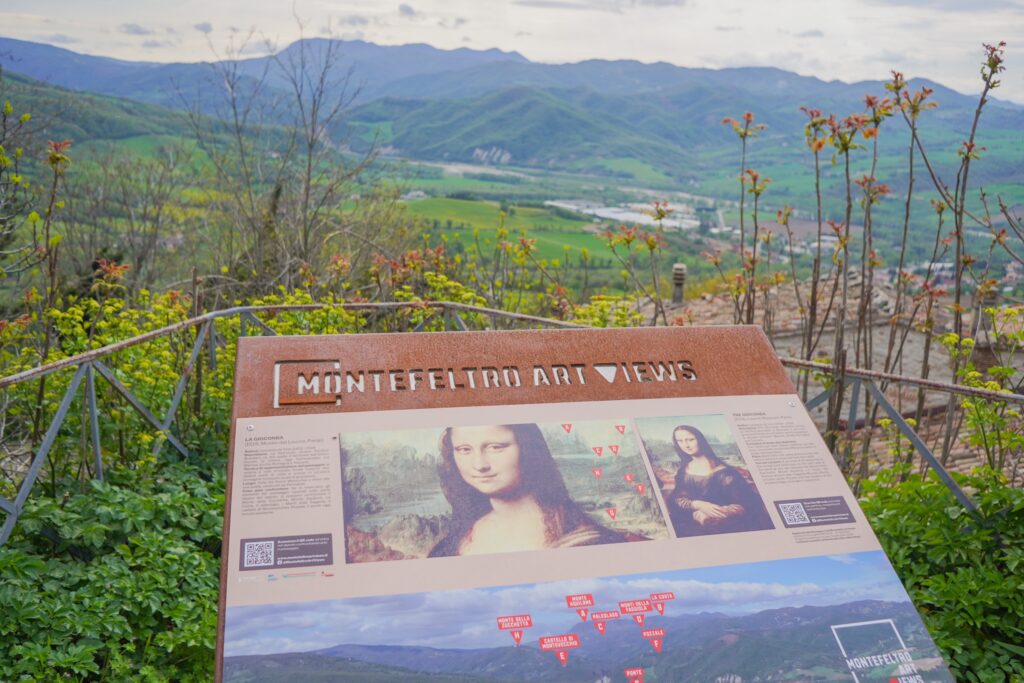
✔️ BONUS: A Waterfall Stop: Cascata del Presalino
If you commit to the slow scenic route back from Pennabilli to the Florence area, be sure to catch the roadside stop-off to get wet in the waterfall of Cascata del Presalino!
The whole drive is stunning up and down and all around this land where these 4 regions meet: Emilia-Romagna + Umbria + Marche + Toscana.
Where to Stay in Pennabilli
If you want peace and quiet and are away from lots of distractions, Pennabilli could be the quaint Italian village for you. I’d start with Booking.com to see options for accommodations in Pennabilli.
Some of the top-rated accommodations in Pennabilli include Hotel Il Duca Del Montefeltro and B&B Fonte Dei Billi.
5. Pistoia
Pistoia is located about 40 minutes outside of Florence, easily accessible by train. It’s a lesser-known town, which means it is less crowded (cue the smiles), yet has a lot of amenities of a city.
We were based in Pistoia for 3 months at a world school called Boundless Life. During this time, we did a lot of exploring in the city, as well as the surrounding area! We travel full time, so exploring is part of our kids’ worldschool curriculum!
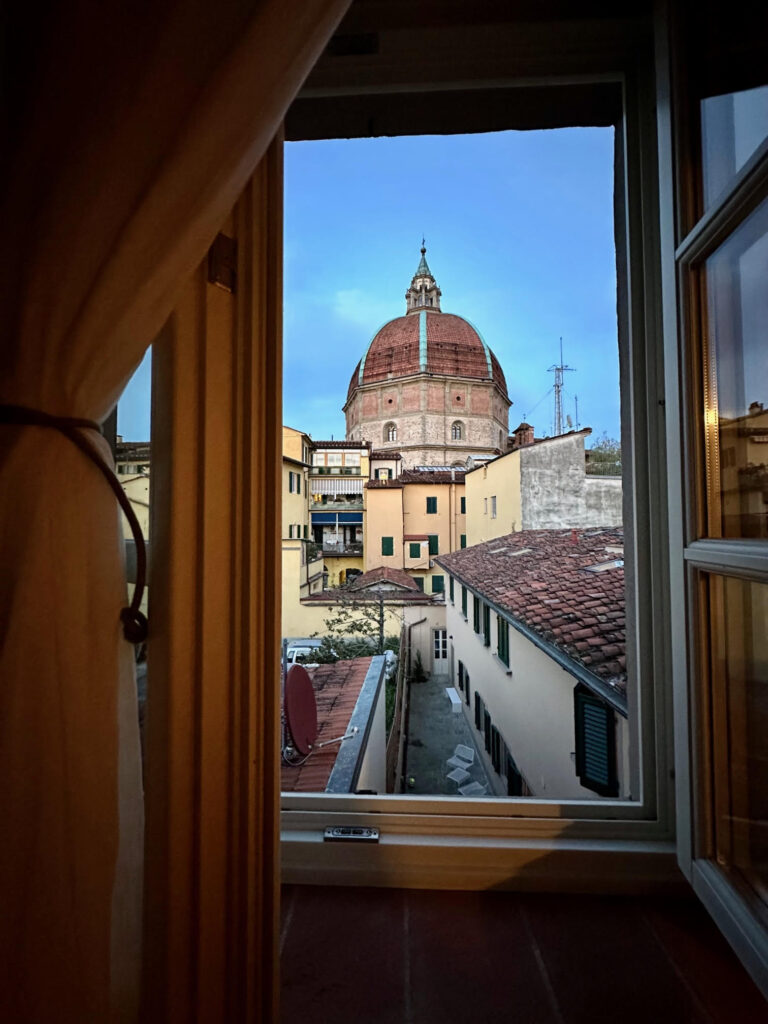
How to Get to Pistoia
It is easiest to take a train, which puts you right in the middle of the city and only a 10-minute flat walk to the historic center.
You can drive, just know that like most Italian cities, there is a historic center where you can’t drive in or you will get fined. Parking can also be an issue. Although we had no issue finding parking on the outskirts of town, especially on the main street in front of the supermarket, Esselunga.
If you want to rent a car in Pistoia, you will only be able to rent a manual, as they rarely have automatics to rent. And note, that they usually close early on Saturdays and are closed on Sundays.
Things to Do in Pistoia
Below are a few things to do in Pistoia. If you are looking for a more in-depth overview of Pistoia, make sure to check out our post on all the best things in Pistoia.
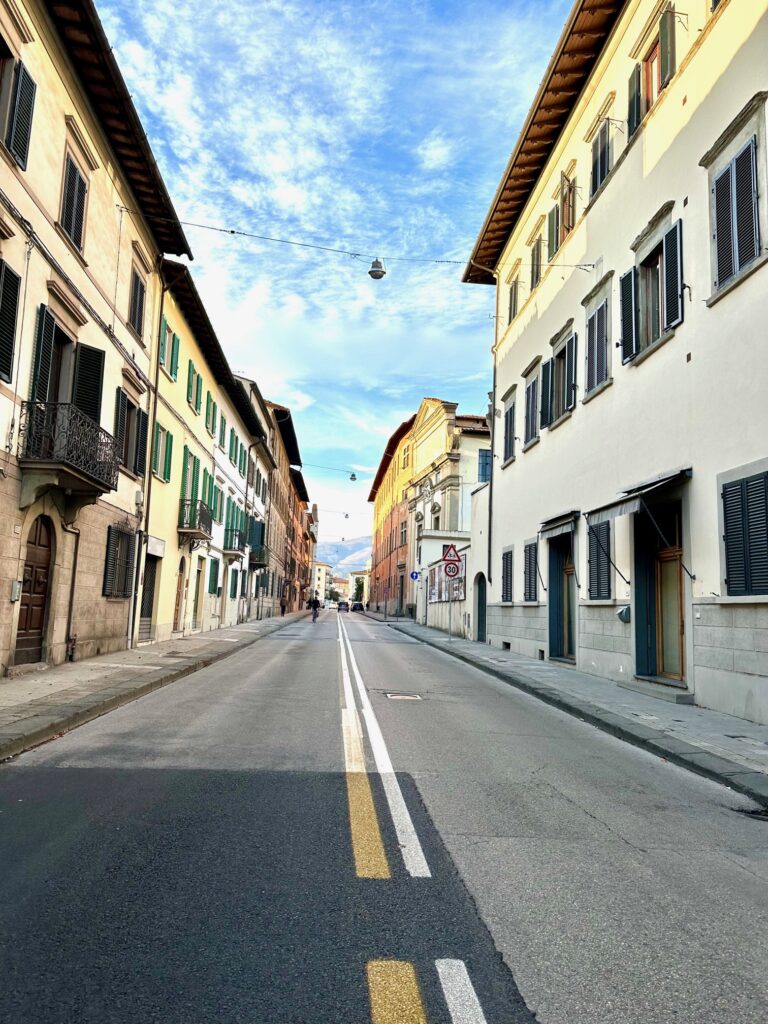
✔️ Stroll through the Town
Walk through the historic center and meander in and out of shops. Stop for a coffee & croissant at Pasticceria Armando, and grab lunch at my favorite: Locanda del Capitano. There are many restaurants to choose from in Pistoia.
✔️ Visit the Street Market
On Wednesday and Saturday mornings from about 9-1 pm, vendors will the streets selling all sorts of goods, as well as produce.
✔️ Explore the Zoo
To be honest, I’m not a huge fan of zoos. But, Pistoia has a nice zoo just outside of town.
✔️ Join a Cooking Class and Olive Oil Tasting
Set up a cooking class and olive oil tasting with the owner of Podere Macolo.
Where to Stay in Pistoia
I would absolutely stay at Palazzo 42. It’s in the heart of town, nice rooms and friends that have stayed there have all loved it.
6. Lucca
A popular Tuscany town that earns a spot on most lists of Tuscany’s best. And rightfully so. Lucca is known for being able to ride atop the city walls around the old town.
How to Get to Lucca
As always, you can drive. But Lucca is right on the train route so it’s much easier to catch a train since you don’t have to deal with parking. The train takes approximately 90 minutes from Florence (Firenze).
Things to Do in Lucca
There are many things to do in Lucca. Here are some of our top picks.
✔️ Ride a Bike
When you exit the train station, there is a bike rental shop where you can rent bikes or these quad and …
We rented this one for our family of 5 + my parents. It was an absolute blast riding along the entire city wall. For reference, in one of these 6-person bikes, you can do the city wall in an hour, although you really can’t waste much time.
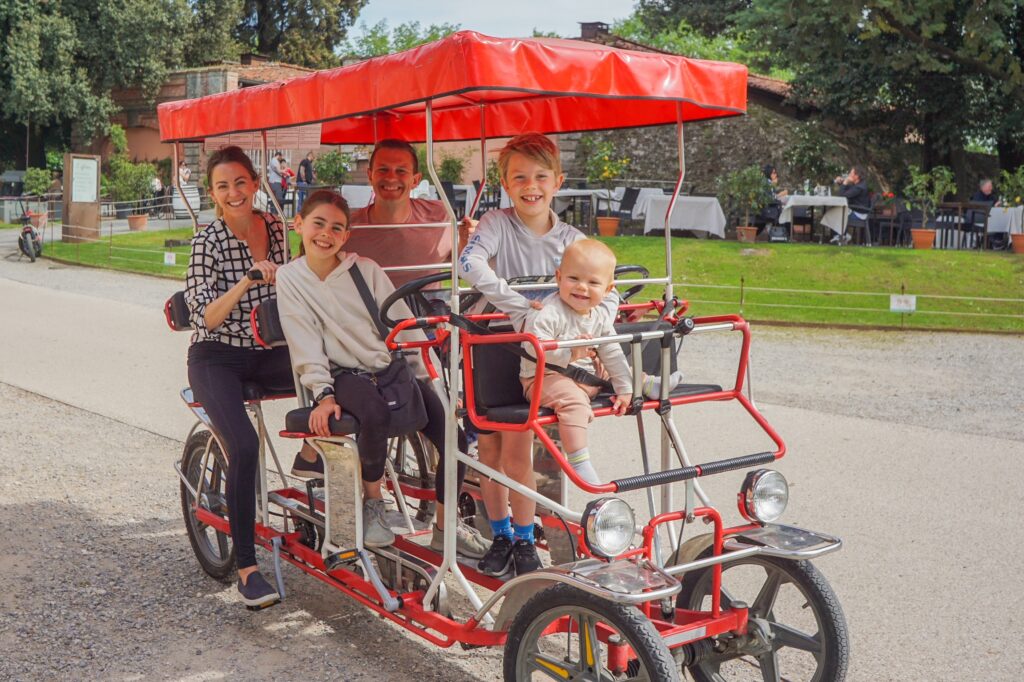
Where to Stay in Lucca
I recommend checking checking out Lucca in Villa Lucrezia orHotel San Marco.
7. Montepulciano
Montepulciano is a medieval town that sits on top of a hill in southern Tuscany. Its beautiful location comes with an abundance of elegant palaces from the Renaissance period, ancient churches, vast vineyards, charming squares, and panoramic views of the Val d’Orcia and Val di Chiana valleys.
I recommend touring around this town on foot since it has many beautiful hidden corners on top of its popular landmarks. The town is also not too crowded although it has become a more popular tourist attraction after the movie New Moon was shot there.

How to Get to Montepulciano
You can get to Montepulciano via car, bus, or train.
How to Get to Montepulciano by Car
I recommend traveling by car to Montepulciano for convenience and better control over your time. If you’re coming from Siena, you can take the scenic route by going south through the Val d’Orcia on the SS2 to San Quirico d’Orcia. You’ll then have to take SS146 through Pienza until you reach Montepulciano.
💡 NOTE: The town’s historic center is closed to traffic. This means you’ll have to park outside the town center unless you have a permit.
You can find several convenient parking lots on the edge of the town. They are well-marked so you can spot them with no problem. The parking fee can be about €1.20 every hour.
How to Get to Montepulciano by Train and Bus
If you prefer public transportation instead of driving, you can ride buses and trains to Montepulciano. The closest train station sits outside of the town and you will still need to ride a bus to reach Montepulciano.
There are buses that run hourly from Chiusi train station. You can catch a bus every 1 and a half hours from Siena. To reach the historic center from the bus station, you can either walk or ride the small orange bus.
💡 NOTE: Keep in mind that the buses may not run on Sundays.
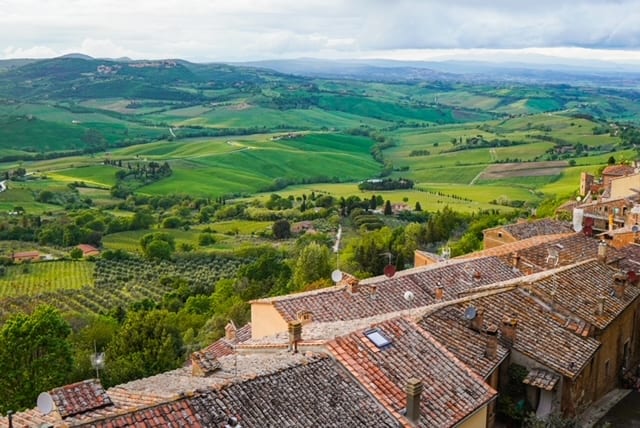
Things to Do in Montepulciano
Make sure to check out these activities in Montepulciano.
✔️ Visit a winery.
Montepulciano is not only known for its charming landscape and architecture. It’s also hailed as one of the best winemaking regions in the world. Their vino nobile is actually globally renowned. It’s a fine red wine made with grapes sourced from the local vineyards surrounding the town.
✔️ Stroll along Piazza Grande.
This is the main square in Montepulciano and is a great location for a relaxing stroll. Within it are important buildings and historical landmarks, such as the Town Hall, Contucci Palace, and Palazzo dei Capitani del Popolo.
You can also find the Well of the Grifi and the Lions and the Cathedral of Saint Mary of the Assumption in Piazza Grande. The cathedral is in prime real estate but may not be as attractive as those in Siena and Lucca.
✔️ Look at scenic views from the clock tower in Palazzo Comunale.
You can climb the 150 steps to the top of the clock tower and have better views of Montepulciano. If you don’t want to take the stairs, you can ride the elevator instead. Although there are still 52 steps left from the elevator stop before you reach the top.
Where to Stay in Montepulciano
It’s really nice to stay in Montepulciano so that you can experience the village without all the daytrip crowds. We ended up visiting Montepulciano in the evening, which was after all the day-trippers had left!
Some of the most highly rated options are Villa Nottola and Hotel Panoramic Montepulciano.
8. San Gimignano
San Gimignano is one of the more famous hilltowns in Tuscany and is enclosed by 13th-century walls. It’s located southwest of Florence and is mostly known for its 14 medieval towers, which gained it the nickname ‘Town of Fine Towers’.
The town also boasts a 12th-century church (Duomo di San Gimignano), a triangular historical square (Piazza della Cisterna), and masterpieces of 14th- and 15th-century Italian art, to name a few.
The famous medieval towers are originally built by patrician families who used to control the town. There were 72 of these tower houses, but only 14 have survived after wars and other catastrophes.
Climbing to one of these towers is among the best things you can do in San Gimignano. The town also has a lot of charming shops and restaurants that you can visit in between touring the various historical sights.

How to Get to San Gimignano
To get to San Gimignano, you can take the train, bus, or car. Just keep in mind that there are no train stations in San Gimignano so you’ll have to transfer from a train to a bus to reach the town.
How to Get to San Gimignano by Public Transportation
The nearest train station to San Gimignano is in Poggibonsi. So if you took the train from Florence or Siena, you’ll have to get off at Poggibonsi and take the bus 130 to San Gimignano.
If you want to skip riding the train altogether, there’s always a bus going to San Gimignano from Florence, Siena, and other nearby towns.
➡️ From Florence, you’ll have to catch bus 131 to Poggibonsi. Once you’re in Poggibonsi, you need to transfer to the #130 bus to reach San Gimignano.
➡️ From Siena, you need to ride the 130A bus. You may need to change buses in Poggibonsi but some of these buses continue to San Gimignano directly.
One thing you need to consider if you want to take the bus is that sometimes, buses don’t arrive on time. You may even have to wait for about an hour.
How to Get to San Gimignano by Car
If you’re driving a car to San Gimignano, the following is the approximate traveling distance from nearby locations:
➡️ Florence: 60 km (1.25 hours)
➡️ Lucca: 90 km (1.5 hours)
➡️ Montalcino: 80 km (1.5 hours)
➡️ Siena: 41 km (45 minutes)
➡️ Pisa: 78 km (1.5 hours)
➡️ Volterra: 30 km (40 minutes)
Driving a car to San Gimignano can give you a much better experience. However, parking can be costly but should be worth it for the convenience of allowing you to leave whenever you want to.
The cheapest parking space is at P1 Giubileo. The rate is only €1.50 every hour and a maximum of €5.00 for an entire day. Subsequent days will be subject to a discount.
P2 Montemaggio, P3 Bagnaia Superiore, and P4 Bagnaia Inferiore have rates that start from about €2.50 per hour and €10.00 for an entire day.
💡 NOTE: P1 is the cheapest parking area but also the farthest from the center of San Gimignano.
Things to Do in San Gimignano
Here are a few things to do in San Gimignano.
✔️ Climb the tallest tower in San Gimignano.
Torre Grossa is the highest tower in town. It’s also called fat tower by some. You can see a much better view of San Gimignano if you climb to the top of this tower.
✔️ Rent one of the 14 famous medieval towers.
Torre Salvucci Maggiore is available for tours. You can even rent it and have a remarkable place to stay as you tour the rest of San Gimignano and nearby towns in Tuscany.
✔️ Explore the historic center of San Gimignano.
There are several piazzas in the historic center of San Gimignano, which has been declared a UNESCO World Heritage Site since 1990.
Here you’ll find several small cafes, boutique shops, and Torture Museums. Many restaurants also offer the town’s famous white wine: Vernaccia di San Gimignano.
You also wouldn’t want to miss Duomo of San Gimignano. This cathedral features frescoes that showcase the stories from both the Old and New Testaments.
✔️ Discover the famous Gelateria Dondoli.
If you love ice cream, or you simply want to know why this place is so famous, you’ll have to visit Gelateria Dondoli in Piazza della Cisterna.
This gelateria has graced a lot of news articles and attracted numerous celebrities. They won the Ice Cream Championship of 2006/2007 and 2008/2009. And their Gelato Master, Sergio Dondoli, also bagged the Master of Art and Craft award in 2016.
Their menu includes all traditional flavors while also offering unique ones, including Dolceamaro which comes with aromatic herbs, and Champelmo which is made with pink grapefruit and sparkling wine.
✔️ Food Tours and Cooking Classes
There are some really great food tours and cooking classes in San Gimignano region. Check them out here for ideas and to book. I would also opt for an organic farm when possible!
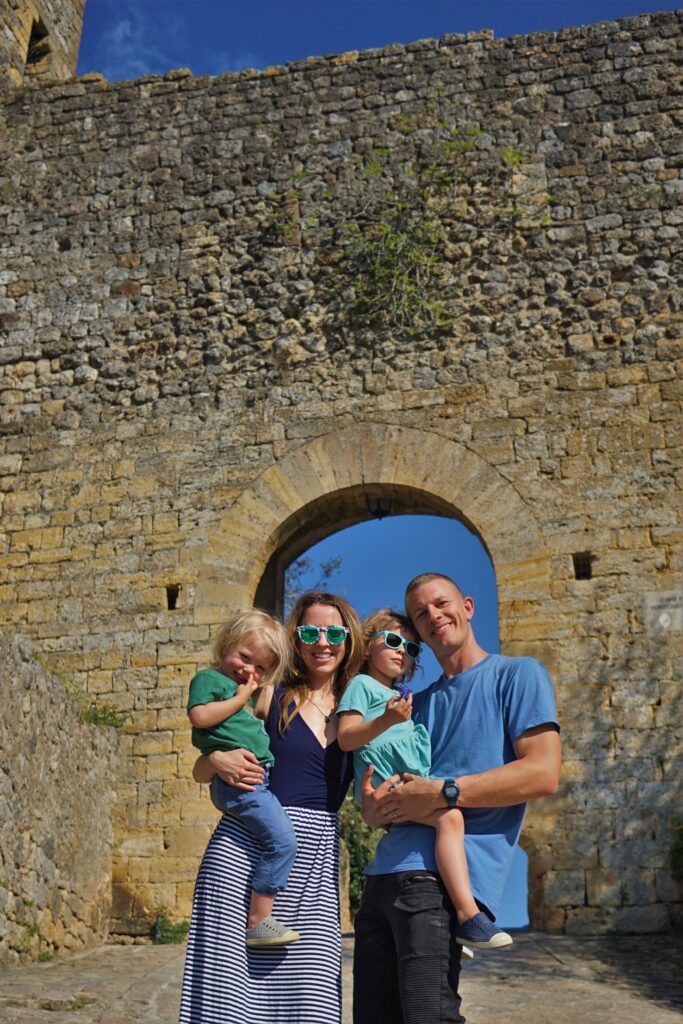
Where to Stay in San Gimignano
Check out some of the top-rated hotels in San Gimignano, such as Hotel La Cisterna and Leon Bianco.
9. Cortona
One of the prettiest towns in Tuscany is Cortona. It’s a small, historic town in the province of Arezzo and lies on the border between Tuscany and Umbria.
Cortona sat atop a hill (600 meters above sea level) and is enclosed with ancient stone walls dating back to the Etruscan and Roman times. It’s also known for its beautiful churches, including the Basilica di Santa Margherita, and panoramic views of Val di Chiana (Chiana Valley) and Lake Trasimeno.
Cortona is also considered the main cultural and artistic center of the Val di Chiana. And while its international fame only skyrocketed when it became the set of the movie ‘Under the Tuscan Sun,’ the town has always offered lots of amazing places and fun things to do for locals and tourists alike!
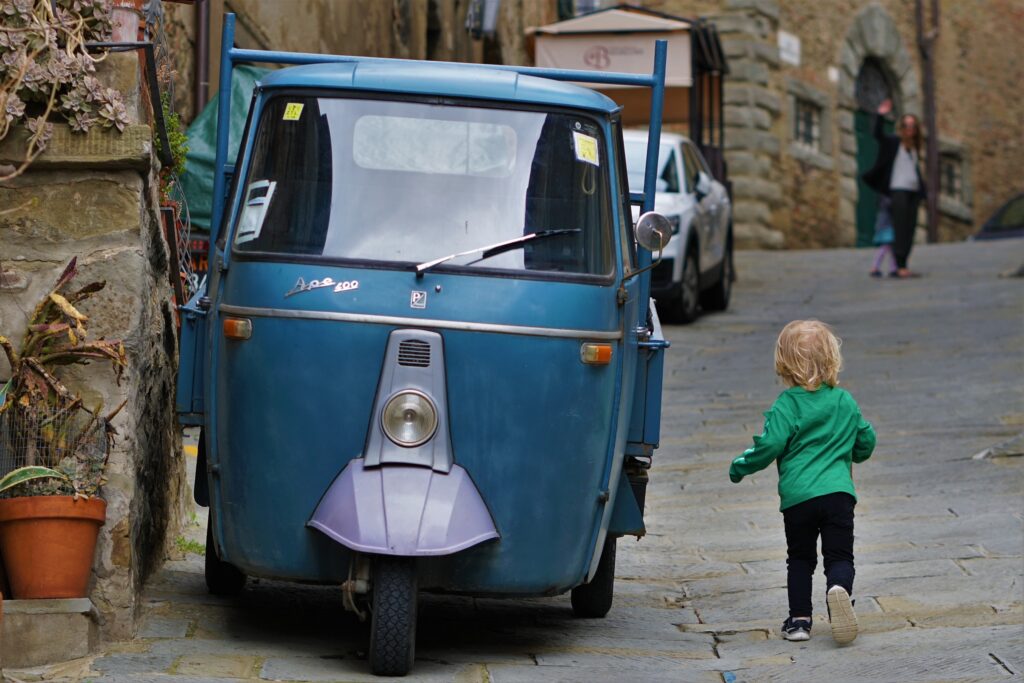
How to Get to Cortona
Depending on your budget and desired level of convenience and comfort, you can reach Cortona via train, bus, and car.
How to Get to Cortona from the Airport
If you’re going to Cortona by plane, you’ll be landing at either of the following closest airports to Cortona:
➡️ Perugia Sant’Egidio International Airport
➡️ Florence Peretola International Airport
➡️ Pisa International Airport
➡️ Rome Fiumicino International Airport
From the airport, you can then ride a taxi, bus, or train.
How to Get to Cortona by Train
You can reach Cortona by train from Rome, Florence, and Venice.
➡️ From Rome
You can pick between a slow or a fast train.
The slow train will take about 2 hours and 25 minutes before stopping at the Camucia-Cortona station.
The fast train only takes 1 hour and 45 minutes but will only stop at Terontola train station which is still 10 km from Cortona.
From the station, you’ll need to ride a taxi or a local bus.
➡️ From Venice
You can ride the fast train Freccia Rossa or Italo Train to Florence, which would take about 2 hours. And when you reach Florence, there’s a local train that will stop at Camucia-Cortona station and only takes 1 hour and 20 minutes.
How to Get to Cortona by Bus
The Camucia-Cortona and Terontola rail stations are both connected to bus services. You will ride the bus up the hill and stop just outside the center at Piazza Garibaldi. You can also ride a bus to Cortona from nearby towns and villages in Tuscany.
How to Get to Cortona by Car
If you’re traveling from Rome or Florence, you can drive through the main highway A! Superstrada del Sole and exit at the sign “Bettolle”. You will then have to take the second exit, “Cortona San Lorenzo”.
Afterward, you just have to follow the road signs to Cortona until the hill appears in about 5 minutes.
Things to Do in Cortona
Add these things to do in Cortona to your list while visiting this charming Tuscan town.
✔️ Visit the Museum of the Etruscan Civilization (MUSEO DELL’ACCADEMIA ETRUSCA (MAEC))
✔️ Shop along the side street of Cortona
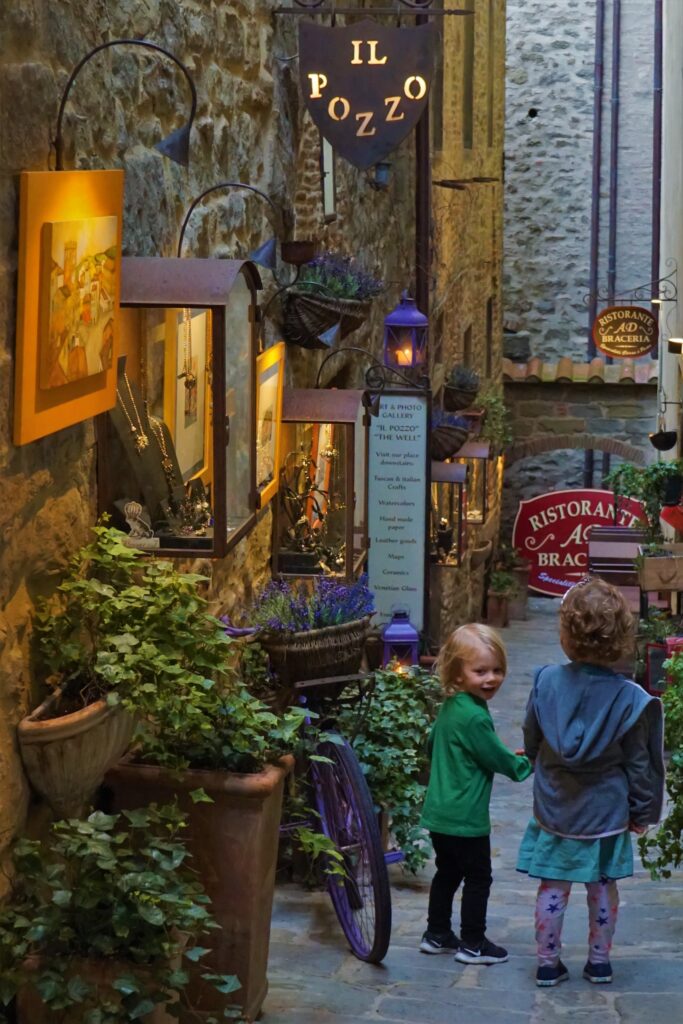
✔️ Explore Cortona on foot through Via Nazionale
✔️ Go sightseeing at Belvedere di Cortona
✔️ Enjoy a delicious gelato
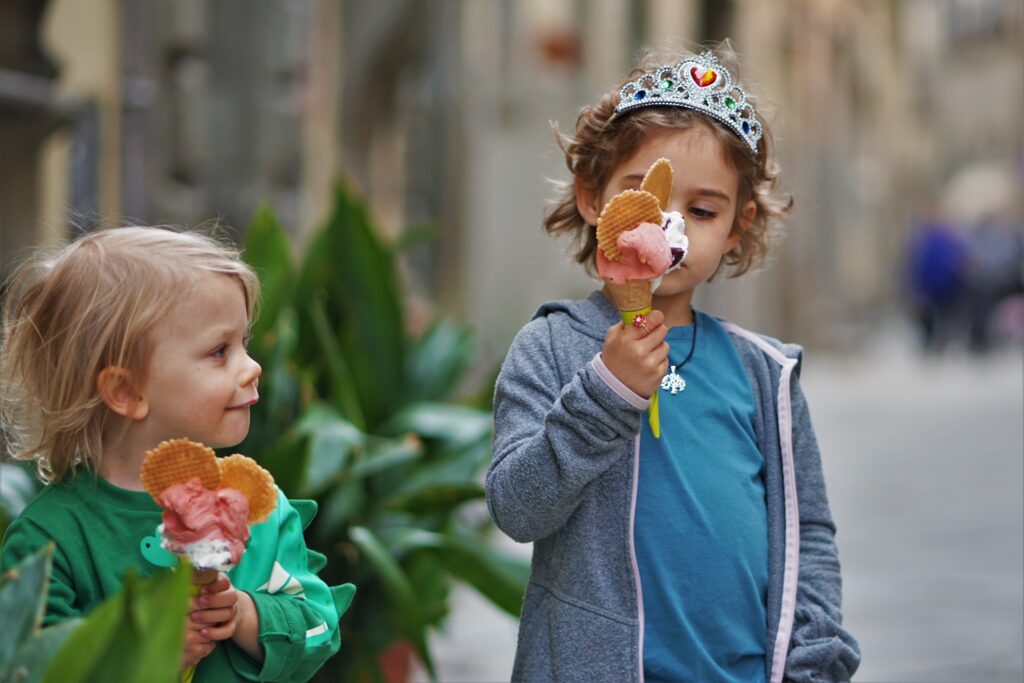
✔️ Visit the Diocesan Museum
✔️ Visit this cute shop for a wine tasting
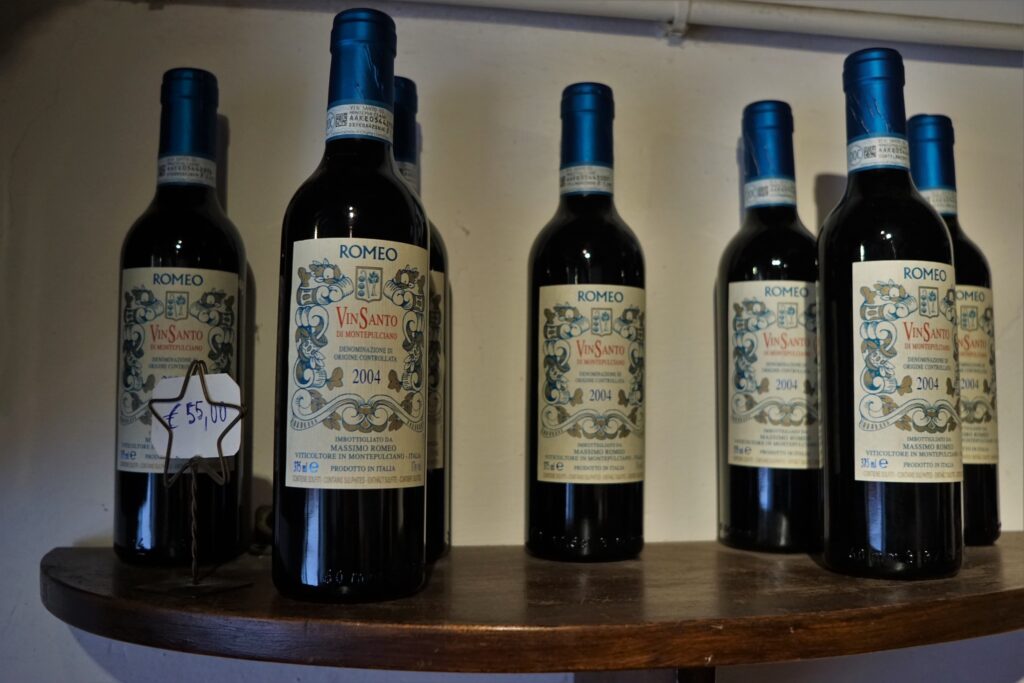
Where to Stay in Cortona
Definitely check out Hotel San Luca or Villa Schiatti.
10. Suvereto
If you’re looking for charming villages in Tuscany, Suvereto is another medieval town that should go on your list.
It’s nestled in the province of Livorno, in between the hills and the Etruscan Coast. Within its walls, you can travel back in time to before 1000 as you gaze upon the prominent old architecture and stonework.
From historical buildings to medieval churches and stone houses, structures all around Suvereto create an ancient yet welcoming atmosphere.
Nature also plays a big role in this Tuscan town’s charm. Suvereto is surrounded by chestnut trees, oak trees, and cork trees (Quercus suber)—which is where the town got its name.
How to Get to Suvereto
You can reach Suvereto by bus, train, ferry, or car.
How to Get to Suvereto from the Airport
Nearby airports to Suvereto include:
➡️ Elba Island Airport
➡️ Pisa Airport
➡️ Florence Airport
➡️ Rome Airport
From the airport, you can ride a bus or train to reach Suvereto.
How to Get to Suvereto by Car
➡️ If you’re from the north, you’ll need to take the A12 Genova-Livorno-Rosignano Marittimo motorway before exiting at Rosignano Marittimo. You’ll then continue to the SS 1 highway and follow the direction for Venturina-Piombino-Elba.
Continue to follow the directions for direction for Venturina-Campiglia Marittima until you reach SS 398, which will take you up to Suvereto.
➡️ If you’re traveling from the south, take the A12 motorway to Civitavecchia then continue on the SS 1 Aurelia to Grosseto. Then follow the directions to Venturina – Piombino – Elba Island then to Campiglia Marittima before taking the SS 398 until you reach Suvereto.
Things to Do in Suvereto
✔️ Explore Museo di Arte Sacra “San Giusto” (Museum of Sacred Art of Suvereto)
✔️ See the 14th-century depiction of Madonna con Bambino at the Chiesa della Madonna di sopra la Porta.
✔️ Tour the inside of the 13th-century palace: Palazzo Comunale.
✔️ Discover the collection of dolls from various eras in the Museo della Bambola.
✔️ Get close to the Romanesque architecture of Pieve di San Giusto.
Where to Stay in Suvereto
Some of the best accommodations in Suvereto include Borgo al Cielo – Albergo Diffuso and Agriturismo Biologico Bulichella.
11. Barga
Barga is a charming town in northwestern Italy, located in the province of Lucca. It’s set on top of the Tuscan-Apennine hills (410 meters above sea level) right in the heart of the Serchio Valley.
Aside from being a beautiful home to around 10,000 people, Barga is also a worthwhile tourist destination. It offers a picturesque view of nature, medieval architecture, tons of outdoor activities, and a dynamic music scene.
Barga is widely recognized in the tourism industry. It bagged several awards, including “One of the Most Beautiful Villages in Italy,” and merits from “Orange Flag Touring Club” and “Cittaslow”.
How to Get to Barga
You can reach Barga by train, bus, or car.
How to Get to Barga from the Airport
There are five airports closest to Barga:
➡️ Pisa Airport
➡️ Florence Airport
➡️ Milan Airport
➡️ Verona Airport
➡️ Bologna Airport
From the airport, you can either ride a bus or a train to Barga.
How to Get Barga by Train
You can only ride trains heading to Barga from Lucca and Pisa Centrale stations.
There are more frequent trains from Lucca and will take you on a direct 40-50-minute ride to Barga.
If you’re leaving from Pisa Centrale, you’ll most likely need to stop at Lucca to change trains. There are only about 5 trains every weekday that go directly to Barga from Pisa Centrale station.
How to Get to Barga by Bus
Buses to Barga mostly leave from Lucca and will take about an hour. And if you’re already in the Garfagnana area, you can catch a bus from Pieve Fosciana, Castelnuovo, and Castelvecchio.
How to Get to Barga by Car
➡️ From the South
Take Highway A1 towards A11 before heading to the Capannori exit. From there, follow indications to SS 439 towards Lucca-Borgo a Mozzano-Fornaci di Barga. You’ll then have to follow the signs to Barga on SS 445.
➡️ From the North
Take Highway A1 following the signs to Genova-Livorno, Viareggio, and to Lucca. You’ll need to exit at Lucca est and follow the indications to Borgo a Mozzano and Fornaci di Barga before taking the SS 445 to Barga.
Things to Do in Barga
✔️ Visit the Romanesque-style Cathedral of San Cristofano.
✔️ Explore in the Museo Civico del Territorio.
✔️ Stroll along the main square of the center: Piazza del Comune
✔️ Visit and learn more about the historic Teatro dei Differenti.
✔️ Admire the 16th-century complex of Santa Elisabetta Church.
Where to Stay in Barga
For some great options to stay in Barga, check out Il Ciocco Hotels and Villa Gherardi – B&B e Hostel.
12. Monteriggioni
Monteriggioni is another one of the walled medieval towns in Tuscany with well-preserved walls, a castle, and defense towers. It lies on the hill of Monte Ala in the province of Siena, where its imposing towers have stood since the beginning of 1200.
💡FUN FACT: The towers are so impressive that Dante Alighieri referred to them as “horrific giants” in his Divine Comedy.
Without a doubt, Monteriggioni has retained its Medieval character, which makes for this circular town’s main charm. But aside from its historic structure, Monteriggioni is also highly regarded for its vast vineyards and several excursion destinations.
How to Get to Monteriggioni
You can reach Monteriggioni by bus or car. Unfortunately, there are no train stations in town. The closest railway station is Castellina in Chianti-Monteriggioni, which is still 3km from Monteriggioni.
How to Get to Monteriggioni from the Airport
There are five closest airports to Monteriggioni:
➡️ Florence Airport
➡️ Bologna Airport
➡️ Pisa Airport
➡️ Bastia Airport
➡️ Forli Airport
From the airport, you can reach Monteriggioni by riding a train. However, if you’re leaving from Pisa, you’ll have to transfer to a bus before reaching Monteriggioni.
How to Get to Monteriggioni by Bus
You can ride a bus to Monteriggioni from the nearby cities, including Florence, Pisa, and Volterra. Bus stops near the castle of Monteriggioni are the Rotonda (main bus stop) and Scuola.
Both stops are about 500 meters from the castle.
How to Get to Monteriggioni by Car
Traveling by car to Monteriggioni is the more convenient option since you’ll have control over your time. However, keep in mind that vehicles are prohibited inside the town proper. You will have to leave your car at either of the several parking lots outside of Monteriggioni.
💡NOTE: All parking spaces require a small fee.
You can get here by car via the Florence-Siena dual-carriageway. You need to take the “Monteriggioni” exit 10km from Siena (the city) and simply follow the directions toward the town.
Here’s the approximate distance and driving duration from several nearby destinations:
➡️ Siena – 21 km (20 minutes)
➡️ Florence – 65 km (1 hour)
➡️ San Gimignano – 28 km (50 minutes)
➡️ Volterra – 40 km (50 minutes)
Things to Do in Monteriggioni
✔️ Taste the traditional red wine of Monteriggioni: Chianti Colli Senesi Monteriggioni
✔️ Visit in July and take part in their famous Medieval Festival.
✔️ Try on some ancient armor and swing a 10kg sword at the Museo delle Armature (Museum of Arms – Monteriggioni in Arms).
✔️ Visit the tiny 13th-century Church of Santa Maria Assunta.
✔️ Enjoy great food and drinks at the heart of Monteriggione: Piazza Roma
Where to Stay in Monteriggioni
Borgo San Luigi and Il Piccolo Castello are great choices of accommodations in Monteriggioni.
13. Fosdinovo
Another small town in Tuscany that is worth visiting is Fosdinovo. It’s located in northern Tuscany just 45 miles north of Pisa. It lies within the drainage basin of Val di Magra and is considered the gateway to the historic Lunigiana region.
Although this town is not a staple in every tourist’s itinerary, I know you won’t be disappointed. It boasts a perfectly preserved castle-fortress and a scenic view of the sea and mountains.
The town is also close to the Apennine and the Apuan Alps. So contrary to the rolling hills that you can find in southern Tuscany, steep hills will meet you in Fosdinovo. Winter may also bring snow to this small village.
How to Get to Fosdinovo
You can reach Fosdinovo by train, bus, or car.
How to Get to Fosdinovo from the Airport
Included in the airports closest to Fosdinovo are Pisa Airport and Florence Airport.
From either airport, you can either ride a bus or train to go to Fosdinovo. Riding a taxi is also another option if you’re leaving from Pisa Airport.
How to Get to Fosdinovo via Public Transport
The closest railway station to Fosdinovo is Sarzana. From there, you’ll need to ride a CTT bus to reach Fosdinovo.
How to Get to Fosdinovo by Car
You’ll need to drive via the A12 motorway and take the Sarzana exit. Continue driving on the Aurelia state road towards Carrara until you reach the crossroads for Fosdinovo. You’ll then need to climb for about 6 km before you reach Fosdinovo.
Things to Do in Fosdinovo
✔️ Explore the town’s main attraction: Malaspina Castle.
✔️ Visit the marble tomb of Galeotto Malaspina in the Church of San Remigio
✔️ Admire the 15th-century wooden statue of the Virgin Mary in the Compagnia dei Bianchi Oratory
✔️ Stroll along the beautiful park in Villa Malaspina
✔️ Learn more about the resistance in the Apuan and Luni areas in the Audiovisual Museum of the 2nd World War Resistance.
Where to Stay in Fosdinovo
Both Castello Malaspina di Fosdinovo and Locanda De Banchieri are highly rated by hundreds of travelers as some of the best hotels in Fosdinovo.
14. Volterra
Volterra is a hilltop Etruscan town in Tuscany. It’s located in the province of Pisa and attracts countless tourists for its archeological sites, museums, excursion destinations, and overall picturesque landscape.
The town’s Etruscan heritage is still evident to this day, especially with the protective walls that have surrounded the town since the 5th to 4th centuries BC.
Volterra is also filled with boutiques and handicraft workshops where you can choose from a wide range of souvenirs. Included in your choice are alabaster handmade objects for which Volterra is highly regarded.
💡 FUN FACT: Volterra is dubbed “the city of Alabaster” for their world-famous work with Alabaster. This ancient tradition originated from the Etruscans.
Tip: Use their Volterra Card so you can save money on most entrance fees to the town’s several attractions.
How to Get to Volterra
You can reach Volterra via train, bus, or car. You also have the option of riding a taxi if you’re leaving from an airport.
How to Get to Volterra from the Airport
There are five airports near Volterra:
➡️ Pisa Airport
➡️ Florence Airport
➡️ Bologna Airport
➡️ Bastia Airport
➡️ Forli Airport
From there, you’ll need to ride a train before transferring to a bus or taxi. However, if you’re leaving from Bastia Airport, you’ll need to ride a ferry and then a bus (or drive) before reaching Volterra.
How to Get to Volterra by Car
Volterra is not too far from the surrounding cities and you can definitely drive there. However, you need to keep in mind that the last kilometers before reaching the town proper might be a tad difficult since the road is very curvy and goes uphill.
If you’re leaving from Florence, you need to take the Firenze-Siena roadway before taking the exit at Colle di Val d’Elsa Nord. You’ll then have to follow the road signs toward SR68 and Volterra.
How to Get to Volterra by Bus
You can take a bus to Volterra from Pisa, Siena, and Florence. However, there are no direct routes and you’ll have to change buses before getting to Volterra.
If you’re at the Volterra Saline-Pomerance train station, take the bus line 780 which is only about a 20-minute ride to Volterra.
How to Get to Volterra by Train
The Cecina-Volterra railway line is the closest train station to Volterra. You’ll have to get off at the Volterra Saline – Pomarance stop, which is still 10km away from the city center of Volterra. However, this line is small so check the train schedules beforehand.
There are larger railway stations that are still close by as well. These are in Cecina and Pontedera.
Things to Do in Volterra
✔️ Taste some delicious Italian delicacies during Volterra’s Saturday market.
✔️ Climb the tower of Palazzo dei Priori to better enjoy the town’s view.
✔️ Stroll along and relax in the town’s main square: Piazza dei Priori
✔️ Pass through the Porta dell’Arco, the oldest gate in Volterra.
✔️ Explore the Museo Etrusco Guarnacci (Etruscan Museum)
Where to Stay in Volterra
Check out Albergo Etruria and Hotel La Locanda for your hotel stay in Voleterra!
15. Pienza
Pienza is a small town perched on top of a beautiful hill in the province of Siena. The town offers magnificent views of Val d’Orcia, encompassing expansive vineyards, rolling hills, charming villas, and rows of cypress trees.
Aside from its natural landscape, Pienza is also famous for its pecorino cheese, historic buildings, and romantic street names. This Renaissance town is known as a legacy of Enea Silvio Piccolomini (Pope Pius II) as well.
Pope Pius II redesigned the town to embody his idea of the ‘ideal city’ with respect to his Humanist vision and philosophy. He tasked architect Bernard Rossellino and the great humanist Leon Battista Alberti to lead the construction project.
After 3 years, they have successfully built the Piazza Centrale, Pienza Cathedral, the Papal Residence, and the Municipal Palazzo, among others. Palazzo Piccolomini is what Pope Pius II chose as his summer residence.
After the redesign, the town, which is previously called Corsignano, was renamed Pienza, which translates to ‘city of Pius’. In 1996, Pienza was officially recognized as a UNESCO World Heritage Site.
How to Get to Pienza
Depending on where you’re traveling from or your personal preferences when it comes to comfort and convenience, you can get to Pienza by car or bus. You might also have to ride a train to a nearby town and then transfer to a local bus since there is no train service in Pienza.
How to Get to Pienza by Car
Pienza is between San Quirico d’Orcia and Montepulciano on SS146. Going there by car is the easiest, in my opinion. You won’t have to rely on bus schedules which can leave you waiting for a long time.
➡️ If you’re from Montepulciano, you can take the road to Torrenieri and SS2. Then, take the SS2 south to San Quirico d’Orcia. You can then find the SS146 which runs east to Pienza.
➡️ If you’re from Siena, you need to take SS2 south to SS146. But if you prefer a more scenic route, you can take SS438 south through Asciano and via Monte Oliveto Maggiore.
➡️ If you’re from Florence, the quicker route is taking the A1 Autostrada and EXIT Valdichiana. This will only take about an hour and 40 minutes. Although this can change depending on the traffic. For a more scenic route, your option is to take the FI-SI (Raccordo Autostradale Firenze-Siena) and EXIT Siena Sud. This can add 20 more minutes to your traveling time.
➡️ If you’re from Rome, take A1 Autostrada and EXIT Chiusi-Chianciano Terme. Depending on the traffic, you can reach Pienza between 2 hours and 3.5 hours.
How to Get to Pienza by Bus
If you don’t want to drive a car, there’s always the option of taking the bus. A bus service between Chiusi train station and Montepulciano can bring you to Pienza. You can also catch a bus from Siena.
💡NOTE: It’s important to study the bus schedules in order to save some time waiting for a bus to arrive. Also, there’s only a limited bus service running on Sundays and public holidays.
➡️ If you’re from Florence, you’ll need to go on a bus to Siena, which could take about 3-4 hours. From Siena, you’ll have to change buses at least once to reach Pienza.
➡️ If you’re from Rome, the entire bus ride to Pienza can take at least 5 hours. You can ride the FlixBus to Siena and then transfer to a local bus to reach Pienza.
Things to Do in Pienza
Pienza is such a small town that I would still recommend visiting it even if you only plan a short visit to Tuscany.
✔️ Visit the previous summer residence of Pope Pius II: Palazzo Piccolomini
Just beside Pienza Duomo, you can see the very walls wherein Pope Pius II resided during summer. There are guided tours for Palazzo Piccolomini that happen at regular intervals during the day. The tours come with a host and an audioguide, and usually last for about 40 minutes.
You will be guided through the different rooms inside the palace. The audio guide will then offer an explanation in your chosen language and in your own time. The tour also includes rooms that can be interesting for kids as well, such as the armor room and the Pope’s bedroom.
To culminate the tour, you will be brought to the amazing suspended garden in Palazzo Piccolomini. This will allow you to bask in the vast stunning views of the countryside. The garden’s strategic location is intentional, placing it at the heart of the vision of the Pope’s ideal town.
✔️ Taste the pecorino cheese that Pienza is famous for.
Pienza is especially proud of its pecorino cheese—and rightfully so!
This cheese is made from sheep’s milk and comes in many varieties. The two main varieties are:
🧀 Red Rind Cheese seasoned with Tomato Juice
🧀 Black Rind Cheese (aged pecorino)
If you want to try some, you can easily find pecorino cheese in the shops all over Pieanza. I recommend trying it alongside some cured meats and a glass of their local wine too! Pasta dishes are often made with the famous cheese as well.
💡FUN FACT: Pienza celebrates ‘Fiera del Cacio’ in September. This is a folkloric event where local producers can test their skills at making cacio wheels roll around a wooden pole. This event is held at Pienza’s main square.
✔️ Stroll along Piazza Pio II
Piazza Pio II is the town’s main square and was named after Pope Pius II. It has a unique trapezoidal shape and is dotted with several important structures, like the cathedral, Palazzo Borgia, Palazzo Piccolomini, and an ancient well called ‘pozzo dei cani’ or dog’s well.
You can find it relaxing to simply stroll through the square and admire the 15th-century buildings. Or if you happen to visit during summer, you might catch one or two concerts being held here.
💡NOTE: Piazza Pio II is car-free. So if you’re driving a car, you have to park at some of the designated parking spaces before coming here.
✔️ Visit Pienza Cathedral and explore the crypt below it
Cattedrale dell’Assunta is Pienza’s cathedral and is located in Piazza Pio II. It was built in the 15th century by architect Bernardo Rossellino. The architecture of the building is a reflection of the Renaissance style and some Gothic influences that Pope Pius II saw and liked during his travels.
And after you’ve admired the cathedral’s structure, I recommend exploring the crypt and labyrinth below it.
The crypt is the San Giovanni church that preserved the baptismal font designed by Bernardo Rossellino. You can see many Flemish tapestries within the crypt, as well as the medieval Santa Maria church.
A little beyond the crypt is the labyrinth: a maze of narrow brick tunnels. Visiting both the crypt and labyrinth can take between 15 and 30 minutes. But unlike in Montepulciano, there are no caves. So I only suggest visiting if you simply want to see the entirety of the cathedral and the church of Santa Maria.
💡NOTE: The cathedral is closed on Tuesdays and visiting hours vary depending on the day and season. It’s best to check their official website prior to visiting.
Where to Stay in Pienza
Relais Il Chiostro Di Pienza and Borgo Sant’Ambrogio – Resort are a couple of highly recommended places to stay in Pienza.
16. Arezzo
Arezzo is technically a city, not a town. But it’s always worth a visit so I wouldn’t leave it out my list.
Arezzo is known as the city of gold and high fashion. Many known artists and poets are from Arezzo, including Giorgio Vasari, Guido of Arezzo, and Guittone d’Arezzo. The Renaissance artist Michelangelo also hailed from the province of Arezzo.
The city is filled with amazing frescoes and sculptures, most of which you can find in churches. Some of the more popular artworks are the painted vaulted ceilings and the 15th-century fresco of Mary Magdalene made by Piero della Francesca in the Arezzo Cathedral.
The Basilica di San Frances also has a chapel that is adorned with more of Piero’s stunning frescoes. And in Basilica di San Domenico, you can find the 13th-century painting ‘Crucifix’ by Cimabue.
Aside from art and history lovers, shopping fans will also find Arezzo worth visiting. From trendy clothes and elegant jewelry to household goods and antiques, you can find all kinds of items you’ll want for a shopping spree!
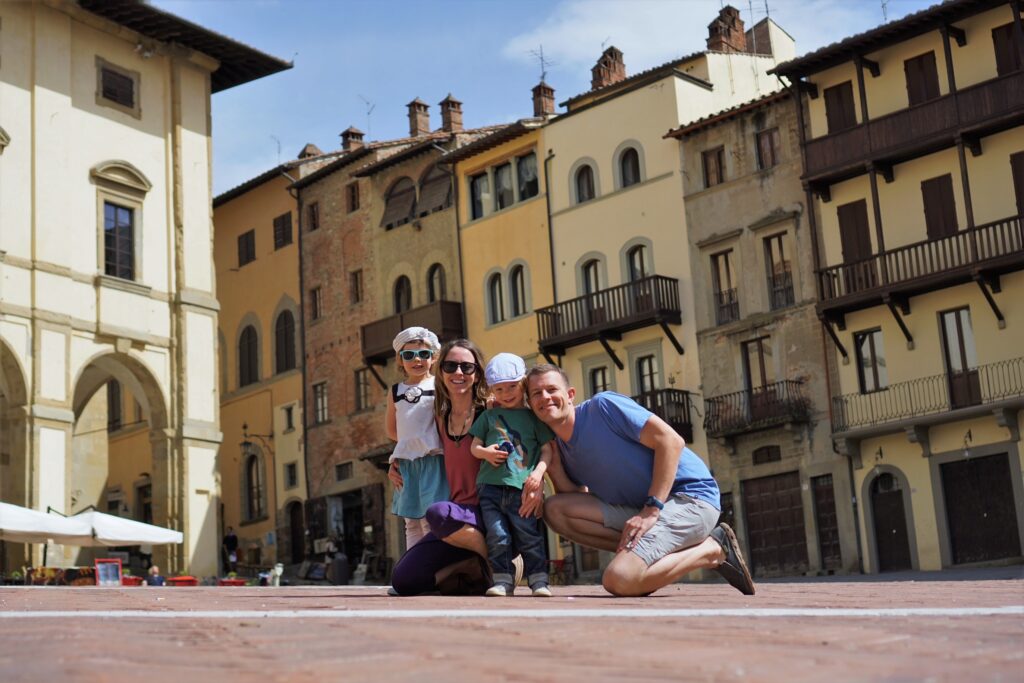
How to Get to Arezzo
In order to get to Arezzo, you can either take the train, ride a bus, or drive a car. For convenience, I always opt for driving a car and suggest you do the same as well.
How to Get to Arezzo by Car
You can easily reach Arezzo by taking the Autostrada del Sole (A1 Milan-Naples). You will then take the exit at the tollgate of Arezzo and travel for about 11km more to reach the city center.
➡️ If you’re from Siena, you first need to take the SS73. This connects to Autostrada di Sole where you’ll then go north before exiting at Arezzo.
But if you want a more scenic alternative to this route, you can always take the exit at Colonna di Grillo and head toward Chianti before reaching Arezzo. Or you can take the exit at Rigomagno and stop at Lucignano before you can reach Arezzo.
How to Get to Arezzo by Train
If you don’t want to drive, traveling to Arezzo by train is also fairly easy. The train station of Arezzo is located along the Bologna-Rome railway line. Trains from Rome, Florence, and other places in Italy frequently run to Arezzo too, so you probably won’t have a very difficult time waiting.
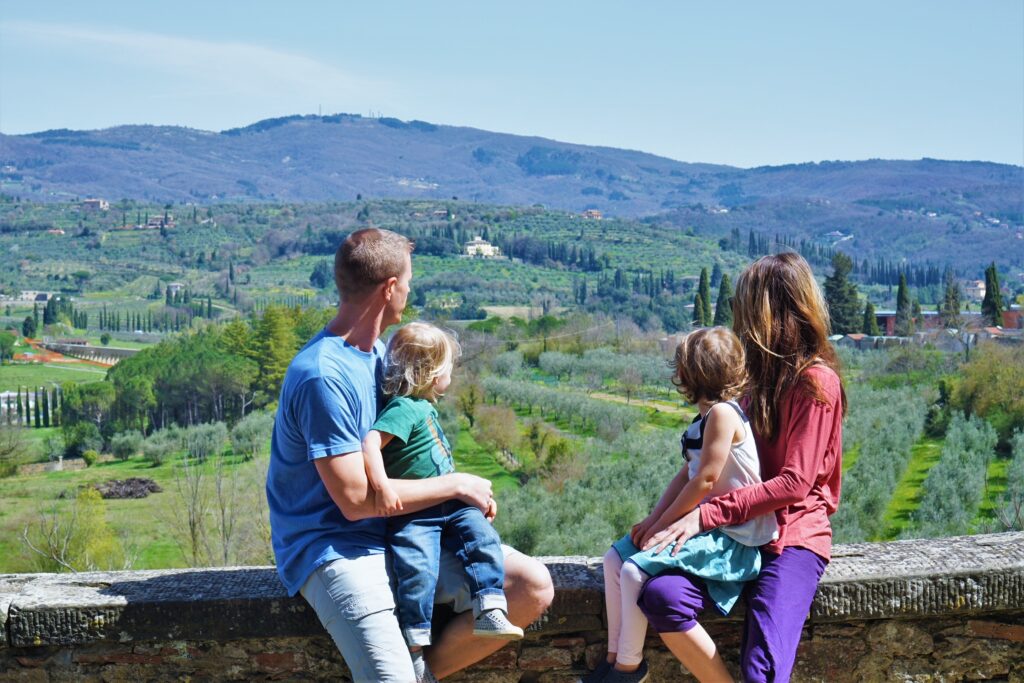
Things to Do in Arezzo
Although Arezzo is out of the way from the more famous tourist spots in Tuscany, this charming city has so much to offer. Whether you’re a solo traveler or you have your family with you, you can find a lot of fun things to do in Arezzo.
✔️ Watch a historical reenactment
If you happen to visit Arezzo on the third Saturday of June and the first Sunday of September, I recommend watching the reenactment of the Saracen Joust held in Piazza Grande. But if your visit doesn’t coincide with these dates, you can still learn about Saracen Joust at the Saracen Jousting Museum.
✔️ Admire the beauty of the Palace of Fraternita dei Laici
This palace is a gorgeous building that you can find in Piazza Grande, the main square of Arezzo. The structure itself is already noteworthy so if you’re in a rush, you can just admire it from the outside.
It’s amazing to see the sculptures of Bernardo Rossellino (the Madonna della Misericordia) and the statues of Pope Blessed Gregory X and St. Donald placed artfully outside of the palace. You can also see one of the oldest functioning clocks in Italy on top of this building.
If you have a bit more time, I suggest going in, especially if you’re fascinated by the arts. Inside the palace is the Museum of Fraternita, which holds a vast collection of 6000 paintings, sculptures, and antique furnishings.
💡NOTE: There is a small entrance fee to the museum.
✔️ Go shopping!
After visiting museums and witnessing historical artworks, you can enjoy yourself more and indulge in some shopping. One good place to do this is Corso Italia, a pedestrian street that’s always bustling with activity. There are a lot of boutiques, antique shops, cafes, and restaurants on this street.
And if you particularly want a plethora of choices when it comes to antiques and other items, I recommend visiting Arezzo on the first Sunday of every month.
During this day, the festive vibe in the city is magnified as approximately 400 stalls open up in Piazza Grande and the surrounding streets. You can find various artwork, furniture, clothing, home goods, toys, and jewelry.
Where to Stay in Arezzo
When looking for places to stay in Arezzo, check out B&B Hotel Arezzo and Hotel Minerva.
17. Pitigliano
Pitigliano is a small town in the Maremma region that was built on a tuff cliff. It’s located on a ridge about 300 meters above sea level and is surrounded by panoramic green valleys. With scenic views and rich history, Pitigliano is one of the best spots in Southern Tuscany.
💡FUN FACT: An ancient legend credits two Romans in the name of Petilio and Celiano for the foundation of Pitigliano. And it is by combining their names that the town got its own name.
Due to its interesting location, it became a unique-looking walled town whose main attractions include its medieval stone streets, museums, and the Jewish quarter.
Ptigliano is actually well known for its nickname ‘Little Jerusalem’. This is because when the Jews were escaping, this town became their refuge in the 14th century. And as their number grew, they built a temple in Pitigliano in 1598.
When the 17th century came, Medici annexed Pitigliano which led to the Jews being confined in ‘ghettos.’ Fortunately, the local government understood the Jews’ vital role in the town’s economic and commercial activities and they worked on improving their status and fundamental rights.
How to Get to Pitigliano
You can get to Pitigliano by car, bus, or train. However, if you’re taking the train, you still need to transfer to a bus in order to reach Pitigliano. There is no train station within the town itself.
How to Get to Pitigliano by Car
Driving a car to get to Pitigliano (and to go around Tuscany) is the best option for me.
➡️ From the North
You need to take the A1 motorway heading to Rome and get off at Orvieto. You then need to take SS71 towards Bolsena, then SS2 Cassia, and SS74 which heads toward Pitigliano.
➡️ From the South
You have to drive through Grande Raccolto Anulare towards Florence. Once you reach Rome, take the A1 highway, turn at Orte, and follow the signs for Viterbo. You just then have to take SS71 until you reach Pitigliano.
➡️ If you’re heading in from Rome, you will have to take the Roma-Civitavecchia motorway and follow the signs for Grosseto-Livorno. You then need to take the exit at Albinia and follow the signs for Manciano. Simply follow the signs for Pitigliano afterward.
How to Get to Pitigliano by Bus
If you don’t feel like driving, there are daily buses that run to Pitigliano from Siena, Florence, and Grosseto.
How to Get to Pitigliano by Train
While you can’t ride a train straight to Pitigliano, you can still take it and stop at any of the following nearby railway stations:
➡️ Grosseto (80km from Pitigliano)
➡️ Albinia (50km from Pitigliano)
➡️ Orbetello (57km from Pitigliano)
➡️ Viterbo (57km from Pitigliano)
From these stations, you can catch a bus that will take you to Pitigliano.
Things to Do in Pitigliano
✔️ Explore the Jewish Quarter
The Jewish synagogue and the museum beside it are worth visiting. The museum will give you an idea of how the Jewish community has lived their daily lives. You can also see the Mikveh, which is a Jewish ritual bath where it’s believed to help people achieve purity. There’s also a butcher shop and bakery called Forno delle Azzime.
✔️ Visit Fontana Delle Sette Cannelle
If you want some nice views, I suggest visiting Fontana delle Sette Cannelle or Fountain of the Seven Spouts in English. It was built in 1545 in Piazza della Repubblica and gives you access to its surrounding magnificent views.
The fountain has seven pipes, as its name suggests, which are each decorated with a sculptured animal head. You can also see some arches that are actually an aqueduct leading to the fountain. These arches were built in the 1600s by Antonio da San Gallo il Giovane in order to supply water to the region, as instructed by the Medici family.
✔ Wander within Palazzo Orsini
If you go to Palazzo Orsini, what you’ll see is an impressive building with high crenelated walls and defensive towers. All of which are the result of several renovations starting from the Middle Ages until the 19th century.
The palace was originally used as a convent but was transformed into a fortress in the mid-13th century by the Aldobrandeschi. Around the middle of the 16th century, this fortress was significantly restructured under the dominion of the Orsini. A transformation was also done during the Lorraine period between 1777 and 1840.
Aside from its noteworthy architecture, the palace also features two museums: Museo di Palazzo Orsini and Museo Civico Archeologico di Pitigliano.
Museo di Palazzo Orsini
This gorgeous museum holds sacred art and liturgical furnishings from the Cathedral of Pitigliano and other surrounding churches.
There are 18 rooms in the entire museum, featuring some famous art pieces like the wooden statue of Madonna and Child by Jacopo della Quercia and the panel Madonna and Child with angels and saints Francesco and Pietro made by Guidoccio Cozzarelli.
Museo Civico Archeologico
This museum serves not only as a gallery but also as a restoration workshop and warehouse. It houses numerous finds from the excavations of the Poggio Buco necropolis and from the finds in Pitigliano. These pieces date back to the Etruscan era.
Where to Stay in Pitigliano
And if you’re looking for something that many other travelers confidently recommend, FicOlivo and B&B Locanda Il Tufo Rosa are two of the many accommodations with a lot of glowing reviews.
18. Monticchiello
Another hill town in Tuscany that is worth visiting is Monticchiello. It’s a small medieval village that is not often included in many traveler’s itineraries but somewhere I still recommend for you stop by. It has definitely a lot to offer not only in sights but also in culture.
Monticchiello is nearby other more famous destinations, like Siena, Pienza, and Montepulciano. It is only a small town but it boasts a stunning natural beauty and a unique theater tradition that distinguishes it from other Tuscan towns.
The town’s famous ‘poor theater’ or ‘Teatro Povero’ offers a theatrical experience that characterizes Monticchiello and its locals. It showcases the day-to-day life in the village, inspired by their local history and re-introducing the customs of rural civilization.
How to Get to Monticchiello
Despite being not as popular as some of the best towns in Tuscany, Monticchiello is easy to reach. You can drive there or opt for public transportation, which consists of a train and bus.
How to Get to Monticchiello by Car
As always, I believe driving is the easiest way to get to Monticchiello. You just have to take the A1 motorway and exit at the Chiusi-Chianciano Terme junction. About 20km ahead of it is the town of Monticchiello.
➡️ From Florence
Take north A1 then exit at Valdichiana. You then have to continue on SP327 toward Torrita di Siena, followed by SP135 and SP17 to Montepulciano. Then simply head towards Monticchiello until the SP88 turn.
How to Get to Monticchiello by Public Transportation
You can take a train and stop at the Chiusi-Chianciano Terme train station. From Chiusi-Chianciano, you can catch a bus to Monticchiello which could take about 2 hours and 10 minutes.
There are also available taxis there. Or if you want, you can drive a car from Chiusi-Chianciano to Monticchiello.
Things to Do in Monticchiello
✔ Catch one of their unique theater performances.
Every summer, there are open-air theater performances in Monticchiello. If you happen to visit during this time, I highly recommend not missing the chance to see it!
This form of theater was first introduced in Monticchiello as a community project. It was 1967 and their community was going through significant changes. The theater then became their way of expressing various thoughts and fears about the said changes.
Over the years, their ‘poor theater’ performances have broached several topics that not only concern the local community but also touch international interests.
✔ Visit the church of Saints Leonardo and Cristoforo
Pieve dei Santi Leonardo e Cristoforo was built in the second half of the 13th century with a Gothic architectural style. Its simple facade has a beautiful rose window above an ogival portal.
The interior was remodeled in the 18th century and has walls that feature many frescoes from the Sienese school. These frescoes date back to the 14th and 15th centuries.
✔ Look for the traitor’s head!
A fun challenge for anyone visiting Monticchiello is to look for the traitor’s head that was oppressed by a cannonball. Hint: It’s on the facade of one of the houses in the village streets, about 5 meters high.
This piece of art was made in the 14th century to depict the traitor who opened the city gates for the Florentine enemies in exchange for two thousand guilders.
Where to Stay in Monticchiello
These two farmhouses having glowing reviews: Agriturismo Riposati and Agriturismo Barbi.
19. Montalcino
In the province of Siena, Tuscany, you will find the interesting hill town called Montalcino. It overlooks expansive Sangiovese vineyards and offers a scenic view of Val d’Orcia.
Montalcino gained worldwide recognition mainly for its two famous wines: Rosso di Montalcino and, of course, Brunello di Montalcino. But even if you’re not a wine enthusiast, there is still a lot in this town that can make your visit worthwhile!
The town can also interest art lovers with its museums and architectural masterpieces. Among its notable sites are the Rocca (a fortress built in 1361) and the tall clock tower. There are also several arts and crafts shops where you can stop by.
How to Get to Montalcino
There are three ways to get to Montalcino: by train, bus, and car.
How to Get to Montalcino by Car
You need to drive about 8km off the SS2 via Cassia. This road runs between Rome and Siena.
You can easily find a rental car in Siena or Florence. And if you don’t like driving throughout your vacation, there are private drivers that you can hire as well.
How to Get to Montalcino by Public Transport (Train + Bus)
There are numerous trains that run on the Grosseto line every day. The nearest stop is at Buonconventio which is still about 14km from Montalcino. From there, you can catch a bus to Montalcino which can take about 30 minutes.
You can also ride a bus from Siena, although you have to change buses once in Buonconvento.
Things to Do in Montalcino
✔ Try Montalicino wine!
Being known for its world-class wines, especially the Brunello, it’s almost a crime not to go wine tasting in Montalcino. You simply have to taste for yourself why their wines are highly praised.
You can find a lot of ‘enotecas’ or wine repositories that offer wine tasting. And if you liked them, you can buy your favorite bottle or two. Most of the wines that they offer for wine tasting are the town’s two biggest sellers, Brunello and Rosso di Montalcino.
Brunello di Montalcino is made from 100% Sangiovese grapes and is aged for 5 years. 2 of these aging years are spent in oak barrels. Brunello can then be released for public consumption on January 1st the fifth year after harvesting.
Rosso di Montalcino is a wine made from 100% Sangiovese grapes as well. The only difference is that the aging duration is not as strict as Brunello’s. Rosso can be released to the market after only a year of aging.
✔ Explore the fortress
The Rocca or fortress in Montalcino has been dominating the town’s skyline since 1361. It was built by the Sienese to mark the passage of Montalcino under Siena’s power.
The fortress sits on the town’s highest point. And if you climb to the top of the tower, you’ll gain access to an uninterrupted view of the natural beauty of Montalcino and Val d’Orcia. You’re also allowed to walk along the walls, giving you more views of the town from different angles.
There are practically no significant changes in the fortress since the Middle Ages. Its mighty structure is now used as a venue for concerts, festivals, and other community events. And every July in the summer, the Jazz & Wine Festival makes the fortress more inviting for locals and tourists alike.
💡NOTE: The fortress courtyard is open to the public for free. However, there is a small fee for climbing the steps to the walls and tower.
Where to Stay in Montalcino
Check out these Montalicino accommodations that are highly rated by hundreds of people: Le Ragnaie and Drogheria e Locanda Franci.
20. San Quirico d’Orcia
San Quirico d’Orcia is one more town in Tuscany that sits prettily on top of a hill. This commune is named after Saint Quiricus and is blessed with a serene natural landscape. The magnificent views in this town include vineyards, olive groves, lovely hills, and lines of cypress trees, to name a few.
History, art, and architecture lovers will also love visiting San Quirico d’Orcia. Here you can see some medieval churches whose structure will make for memorable photographs!
During medieval times, San Quirico d’Orcia was in a strategic location where emperors, pilgrims, and merchants constantly pass through. In fact, Emperor Federico Barbarossa camped here in 1154 and met with the pope’s emissaries to talk about his coronation.
How to Get to San Quirico d’Orcia
It’s easy to get to San Quirico d’Orcia by driving. If you’re from Siena, simply take the SR2 and it will lead you straight to the heart of Val d’Orcia.
And if you choose to try public transportation, just keep in mind that there are no train services in the actual town. The nearest station is still in Buoconvento. From there, just hop on to a TIEMME bus and you can reach San Quirico d’Orcia.
Things to Do in San Quirico d’Orcia
✔ Walk along Horti Leonini
One of the attractions you shouldn’t miss in this beautiful Tuscany town is Horti Leonini. It’s a Renaissance garden that dates back to 1581. This stunning Italian-style garden is named after Diomede Leoni to whom this land was gifted by Francesco I de’ Medici.
Horti Leonini is located in the main square of San Quirico d’Orcia. It features geometric box hedges, a crumbling stone tower, and manicured green space that makes for a relaxing strolling area.
✔ Admire the Collegiate Church of Saints Quirico and Giuditta
Collegiate Church of Saints Quirico and Giuditta is an admirable Romanesque church built with cream-colored stones. This makes the building even more attractive in daylight, beckoning tourists to look and take photos.
This church is dedicated to Quiricus, a 3rd-century child martyr. And aside from his depiction of the altar, the church design also includes the rare example of Lombard style in Tuscany.
Among the church’s three doorways, one was credited as a masterpiece of Giovanni Pisano. Other remarkable works in the church’s interior include the altarpiece by Sano di Pietro, a 15th-century painter from a Sienese school.
✔ Celebrate Festa di Barbarossa
As I mentioned above, Federico Barbarossa camped in San Quirico as he was on the way to his coronation. And in honor of him, the town now celebrates Festa di Barbarossa in June of every year. This fest includes people donning beautiful costumes and participating in period archery tournaments.
Where to Stay in San Quirico d’Orcia
Hotel Palazzuolo and Antica Sosta are great places to stay in San Quirico d’Orcia.
21. Anghiari
Although this is the last in my list of best towns in Tuscany, Anghiari is by no means the least of them. This hill town found in the province of Arezzo is also a charming village that still clearly depicts its medieval roots.
During the Medieval Ages, Anghiari played a vital role in war. The flat valley under it became the place where the famous Battle of Anghiari transpired in the year 1440. This is where the Florentine troops won against the Milano army.
Anghiari is enclosed in massive walls built in the 13th century. To this day, the walls still stood tall, preserving the original atmosphere in this small medieval town.
Anghiari is now considered one of the most beautiful villages in Italy and was awarded an Orange Flag distinction from the Italian Touring Club.
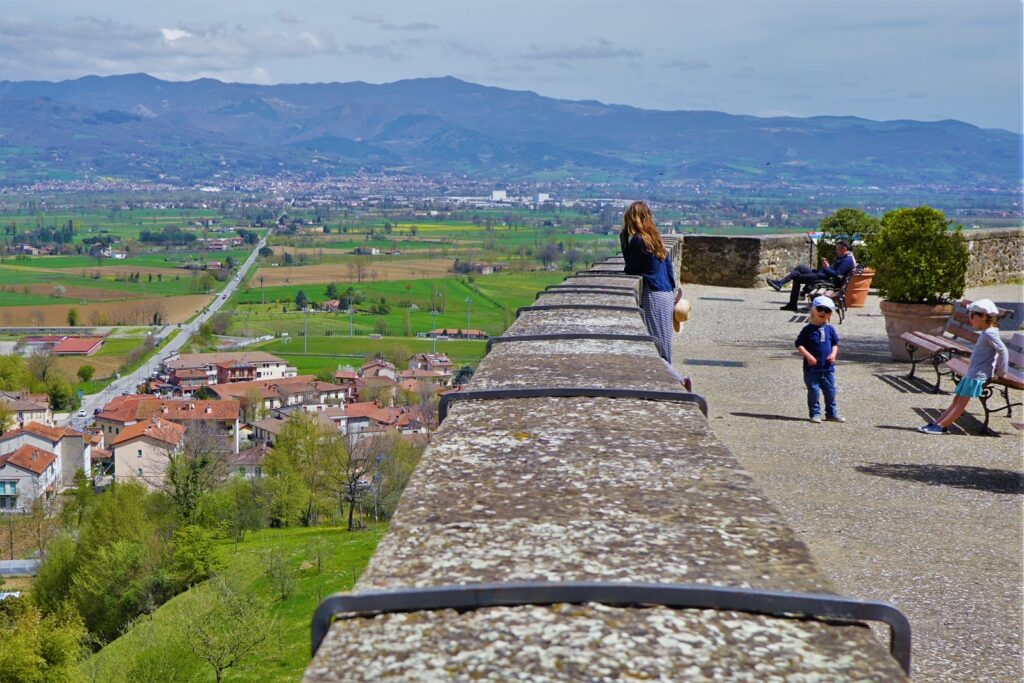
How to Get to Anghiari
To get to Anghiari, you can either drive a car or take public transportation.
If you’re driving from Florence, you just have to take the A1 road towards Arezzo, and then go on E78 or SP43 (Strada Provinciale della Libbia). You will then find Anghiari along E45 by the Sansepolcro exit.
For public transport, I recommend taking the train to Arezzo where you’ll then have to transfer to a bus in order to reach Anghiari.
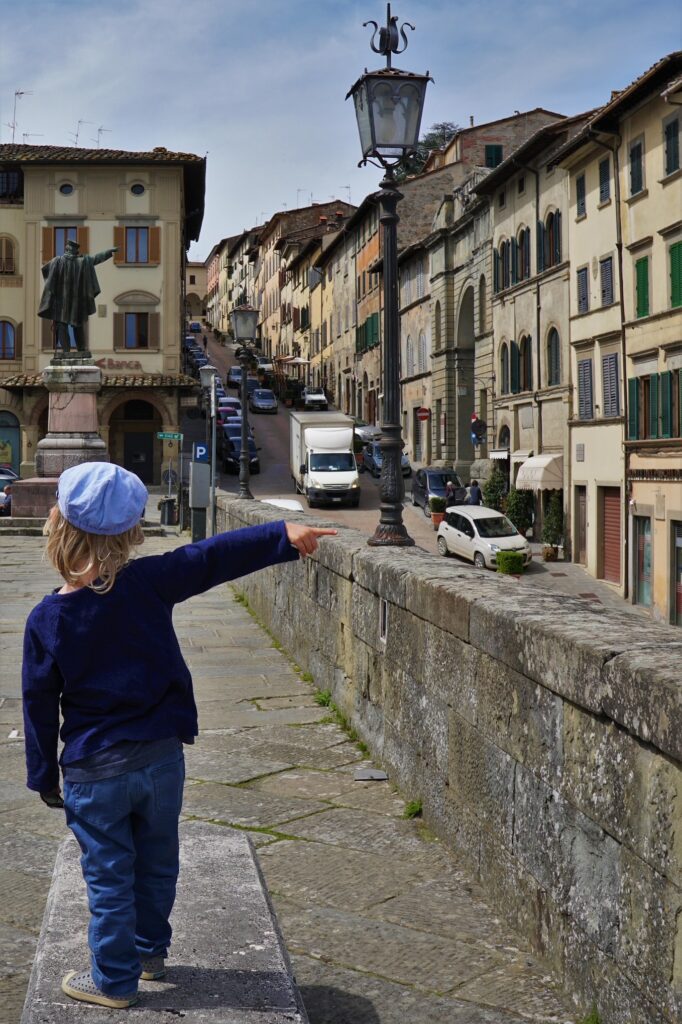
Things to Do in Anghiari
✔ Explore the museums
The Battle of Anghiari was painted by Leonardo da Vinci to honor the victory and materialized its glory. However, the original artwork was lost. What remained is the copy made by Paul Rubens, which you can find in the Museum of the Battle and Anghiari.
There are also other museums in Anghiari, such as the State Museum and Misericordia Museum.
You can find the State Museum in Palazzo Taglieschi where it housed its prestigious art collection, including the polychrome wooden Madonna made by Jacopo della Quercia.
✔ Visit various castles and palaces.
Like the other medieval towns in Tuscany, Anghiari comes with its fair share of historical castles and palaces. Some of these are the Castle of Galbino, which was made back in the year 1000, and the Castle of Sorci, which now houses a highly acclaimed traditional restaurant.
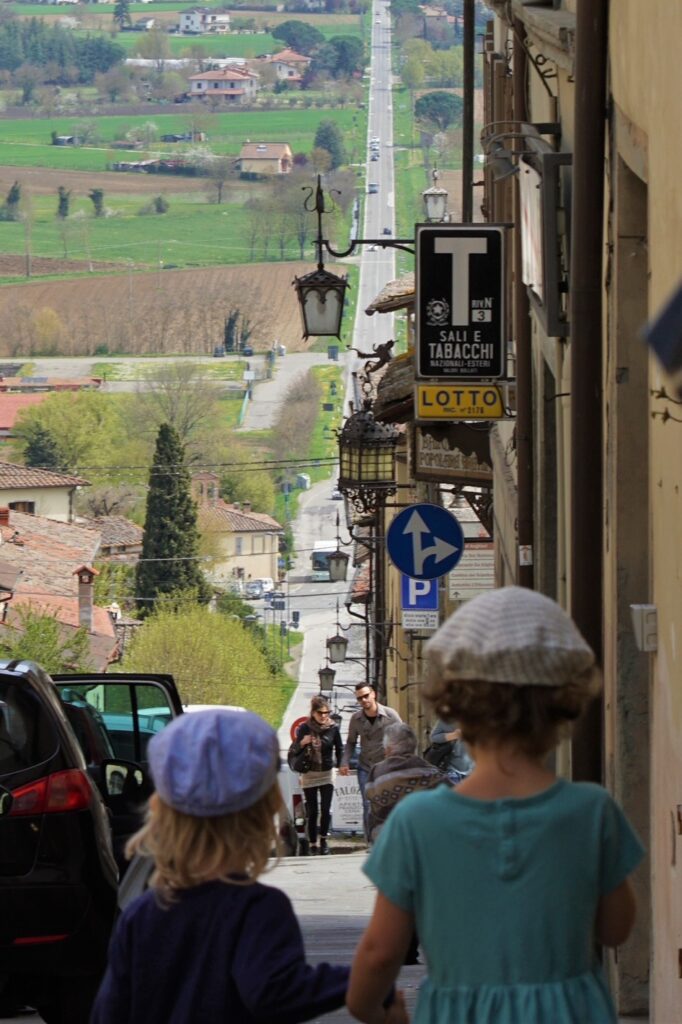
Where to Stay in Anghiari
There are many great places to stay in Anghiari. A couple of these are Hotel La Meridiana and Locanda Del Viandante B&B.
For more options that fit your budget range and preferences in amenities, I suggest heading to Booking.com.
Bonus: Unique Day Trips from Tuscany
Just to throw in a couple of bonuses for you. Here are some great day trips in Tuscany and from Tuscany.
⭐ Florence American Cemetery
Car travel time: 40 minutes (not near a train nor town but easy access off the highway outside Florence)
For you Americans or history hounds, we chose to stop on our way back from Sienna at the Florence American Cemetery (free parking and admission). This pristine park pays tribute to the 4,402 American soldiers buried there who lost their lives during WWII, pushing up the length of the Italian countryside to clear the enemy lines.
What a perfectly preserved place of peace. Extremely somber and mesmerizing and important and impactful. Be sure to walk to the top of the hill to read through the history of the route the battalions advanced now and forever etched into stone.
A very special place.
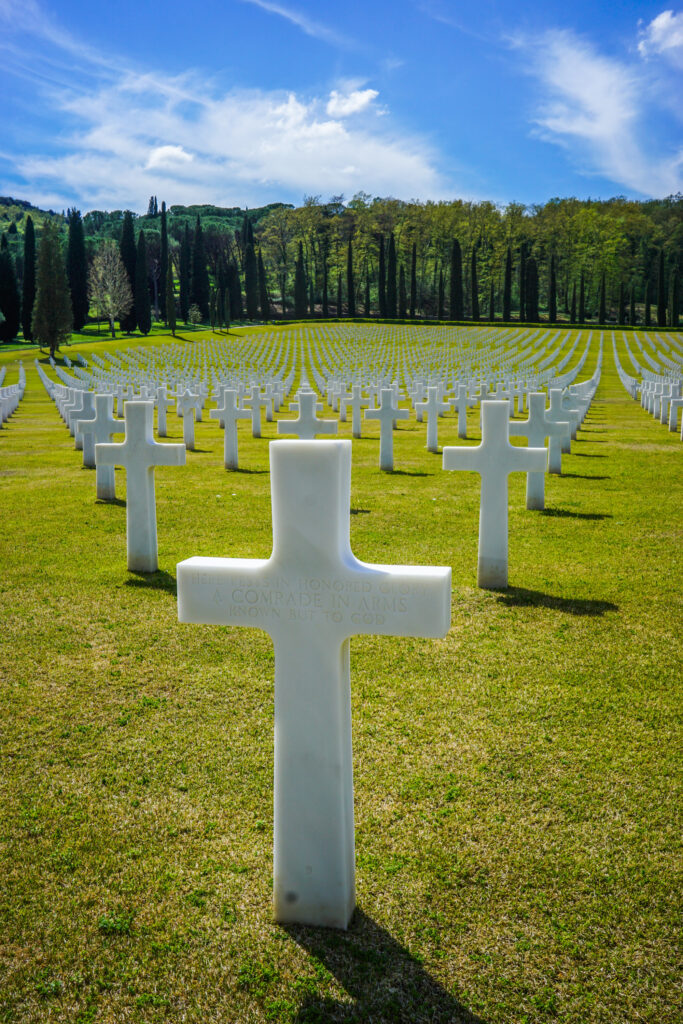
⭐ Asmana Wellness World Firenze
Italy is known for its wellness centers. It’s part of their culture of health.
Asmana Wellness is a wellness center and spa just outside of Florence. I’ve had multiple friends who have raved about it. From the fresh juices to the saunas, wellness water journey, and even napping spaces, it’s the perfect place to rejuvenate your body and mind!
To get to Asmana, it’s best to have a car. However, you could take a combination of a train + bus + a little walking.
⭐ Bagni Di San Filippo
About a 2 hour drive from Florence, Bagni Di San Filippo is an amazing giant natural mineral hot spring. It is a fabulous free way to spend a day. The white calcium waterfall seemingly frozen in time holds hot waters careening down it with cut out tubs perfect for lounging in. Named the white whale, this beast of a beauty was super relaxing and didn’t cost us a cent!
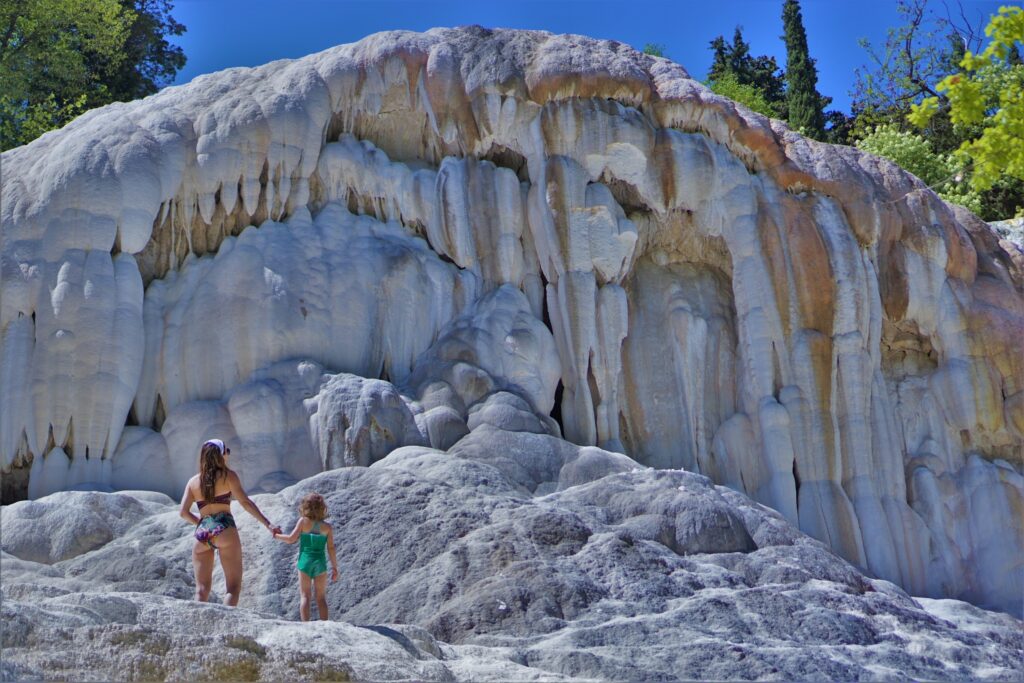
⭐ Portovenere
Located about 2.5 hours from Florence is the seaside picturesque town of Portovenere. We originally planned to take the dayboat from La Spieza to Portovenere through to Cinque Terre. However, upon arrival at the ticket booth, we discovered the seas were too strong for the ferry to turn the corner past Portovenere to Cinque Terre.
So we changed plans and chose to explore the seaside harbor town of Portovenere instead. The harbor holds multi-colored building facades and winding streets lined with shop after shop of food and flavors to fill up your day. Portovenere ended up being one of our favorite stops and less crowded than Cinque Terre!
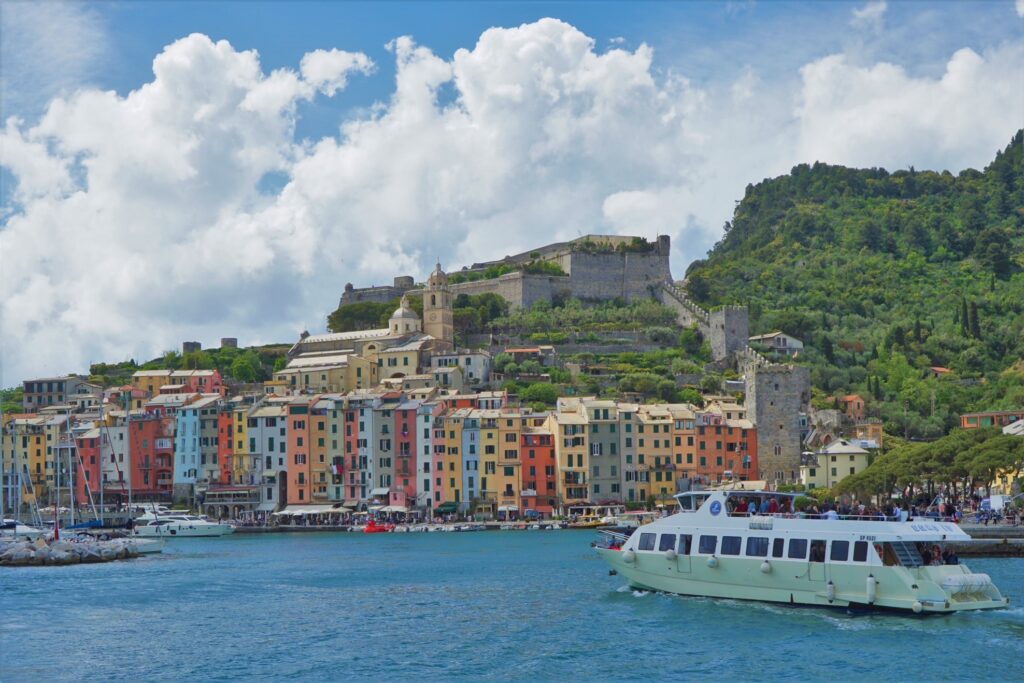
⭐ Civita di Bagnoregio
Civita di Bagnoregio is one of the coolest towns in Italy. You can only access this quaint medieval town via the pedestrian bridge. The hill which holds Civita di Bagnergio is eroding so there aren’t many inhabitants left. Yet is still has some charming shops and restaurants and is one of my favorite day trips from Tuscany.
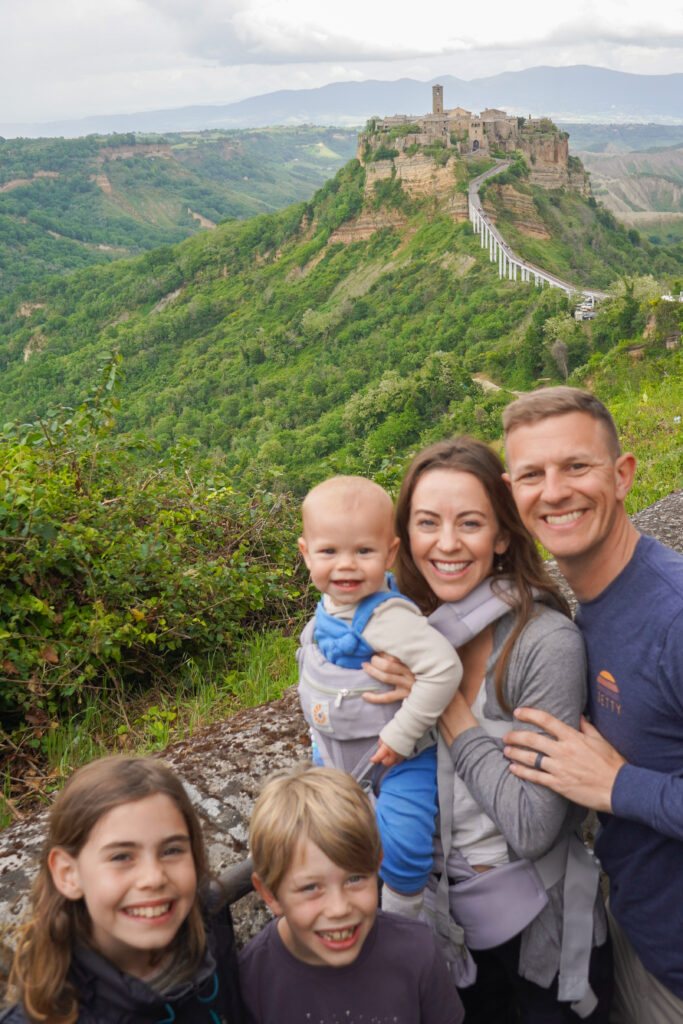
⭐ Lucignano
An unlucky day of the week choice for us as the museum holding the Tree of Love was closed on the Tuesday that we visited. The story of the golden gilded tree that took over a hundred years to craft led us to Lucignano but the charming concentric circling cobblestone streets on our cloudy day there brought us back in time.
⭐ Collodi
We only had time for a quick stop in the quaint Collodi, but we got a glimpse of the Pinocchio crazed town including the tallest Pinocchio in the world.
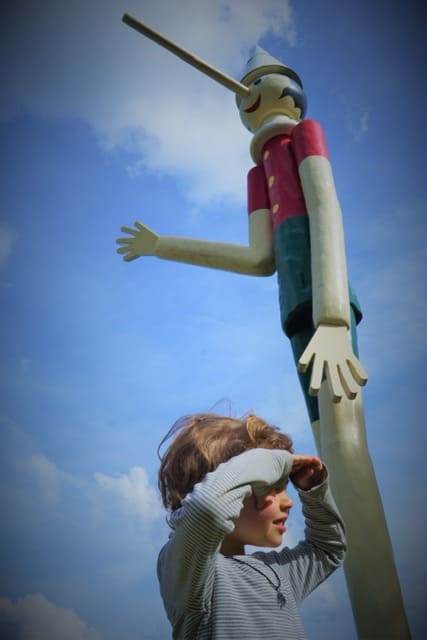
How many days do you need in Tuscany, Italy?
The amount of time you need in Tuscany depends on how much you want to see. You most likely can’t see it all. I’ve spent over 4 months traveling throughout Tuscany and haven’t seen everything!
Some people come via cruise for a day and pop into Florence and maybe Lucca. Others stay for a week driving around to multiple small villages and larger towns. And some, like myself, stay for months.
My advice is to get clear about what is important to you. When you are on your way home from your trip, what do you want to feel? What will you be glad you experienced? If you also want to feel refreshed, remember that you don’t need to see it all.
No matter how much time you have in Tuscany, I think Tuscany is best experienced by doing these three things:
✔️ Visiting a popular town (such as Lucca or Florence)
✔️ Visiting a smaller village
✔️ Seeing the rolling green hills (which can be done in conjunction with visiting a winery)!
What is the best time to visit Tuscany?
The best time to visit Tuscany is the Spring or Fall. The shoulder seasons essentially are when the crowds dissipate, the weather is a bit cooler and you can really enjoy the beauty in Tuscany. Of course, truly you should visit Tuscany during the time of year that best suits your preferences.
How to get around Tuscany?
To get around Tuscany, you can take the train, rent a car or take a bus. The other more expensive option would be to hire a driver.
If you are staying outside of the city center, I would recommend renting a car. It’s truly the best way to see the Tuscan rolling countryside and smaller villages.
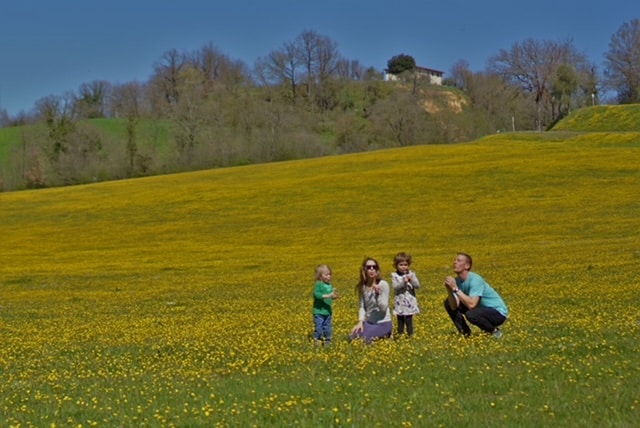
FAQs about the Best Towns to Visit in Tuscany
Curious about the best towns to visit in Tuscany? Here are some of the most common questions:
Which is the prettiest part of Tuscany?
Cortona and San Gimignano are among the prettiest towns in Tuscany.
Going to Piazza Garibaldi in Cortona will give you a fantastic vantage view of its surrounding hills and valley. And if you prefer a charming cityscape, San Gimignano offers the iconic medieval towers Torre Grossa and Torre Rognosa. You can even climb inside these towers to better appreciate the panoramic view of the Tuscan countryside.
Check out some Tuscany inspiration:
Where are the best areas to stay in Tuscany?
Florence is one of the best areas to stay in Tuscany. It’s the capital city and the region’s primary tourist hotspot, which gives you a wide range of options for accommodations that fit any budget range. Also, a lot of attractions and must-try activities are conveniently nearby.
Siena is another good base in Tuscany. It’s located in the center of the region and will put you close to other must-visit places in Tuscany.
What is the safest city in Tuscany?
Florence is the safest city in Tuscany with a safety index of 70. It’s even one of the safest cities in Italy.
You don’t have to worry about going to other places in Tuscany as well. Tuscany is considered one of the safest regions in Italy so exploring its glorious towns won’t pose too much of a risk.
However, keep in mind that safety precautions are still advisable, especially in touristy areas where pickpockets and the like may be present.
What is the most famous part of Tuscany?
The historic cities of Florence and Siena are among the most famous parts of Tuscany.
Florence is Tuscany’s main tourist hotspot and is known as the birthplace of the Renaissance. On the other hand, Siena is home to the world-renowned cathedral of Piazza del Campo, where the famous Palio horserace is held twice a year.
Pisa is also high on the popularity list. It’s mainly known for its leaning tower but also for the Square of Miracles and Arno River, to name a few.
What town is the heart of Tuscany?
Florence is mainly considered as the heart of Tuscany but others also take Pienza as the real heart of Tuscany.
Pienza is a Renaissance town that offers the most picturesque areas in Tuscany. It’s nestled on Tuscan hills where you get to see Renaissance palaces and the unobstructed view of the Val d’Orcia landscape.
If you’re going on a drive through the heart of Tuscany, your route will pass through Pienza, Montepulciano, Monticchiello, Val d’Orcia, and Bagno Vignoni.
What are some non-touristy towns in Tuscany?
Pitigliano, Barga, Suvereto, and Arezzo are some of my recommended non-touristy towns in Tuscany. You can enjoy a lot of fun activities, explore historical places, and bask in the magnificent natural view in these places without being thrust into overly crowded places.
What are the best towns near Florence, Italy?
San Gimignano, Monteriggioni, and Volterra are among the best towns near Florence, Italy. You can easily explore them by car or public transport if you choose to stay in Florence.
Final Thoughts about the Best Towns in Tuscany
There are so many amazing towns in Tuscany. Venture out, explore the countryside, the villages, the olive farms, the wineries. Stop and enjoy the views.
My recommendation when checking out these best towns in Tuscany: Don’t try to see it all. Plan your meals around siesta so you aren’t left hungry. Go a little off the beaten path where there aren’t so many tourists. Have conversations with locals.
Enjoy all that Tuscany has to offer!
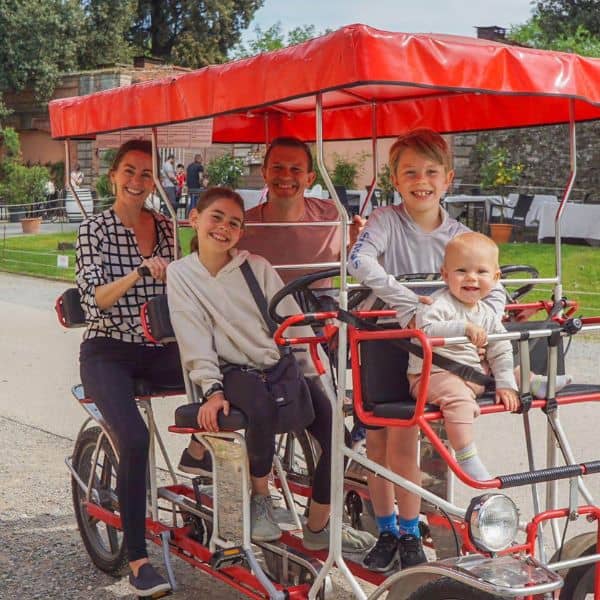
About the Author
Michelle Schomp is the co-founder and main writer of Passport Explorers.
She loves to explore new places together with her husband and three kids. And as they travel the world and gain new experiences, she loves to share everything she’s learned with all of you!
You can find more of her and her family’s adventures on YouTube.
